about the writer
Jennifer Adams
Jennifer D. Adams is an associate professor of science education at Brooklyn College and The Graduate Center, CUNY. Her research focuses on STEM teaching and learning in informal science contexts including museums, National Parks and everyday settings.
Jennifer Adams
How can art be better catalysts to raise awareness, support and momentum for urban nature and green spaces? This was a hard question for me to address because of the way art, urban nature and green space are positioned vis-à-vis each other as if they are separate, however both subjugated to some dominant discourse of the role of art and nature in urban contexts. The question seems to position art and nature at the margins of urban life and one is needed to raise the awareness of the other. However, as bell hooks notes, agency is at the margins because it is here that a discourse that is created that is counter to the dominant discourses of power and causes us to rethink the kinds of relationships that we have not only with each other but also with the places in which we enact our daily lives. Urban nature and green spaces are these places. Art happens in these places. These places exist and are in our awareness, however this awareness may not look like what the dominant discourse of environmental awareness dictates.
Embodiment of art and nature
Sunday morning, a circle of grain marks a sacred space. A gentle pulse builds to a strong beat. The pulsing of the Earth resonates in the rhythm of drummers’ hands on skin rising up and filling the space between the trees. Dancing feet pick up dust as moving bodies, twirl and jump, marking time with the rhythms of the Earth. In the sacred circle, “places, memory, experience, and identity are woven together over time.” In this space, time collides, moves and stands still. The expression of it all is in a breath, a breath that circulates carbon and oxygen and connects living and non-living beings.
The art that I describe here is a participatory art that happens in an urban green space. It is a weekly drumming circle that draws dancers, drummers and appreciators into the space to create a collaborative and fluid expression of art. The location of the circle, in a public green space, is essential to the production and is a part of the creation of the art. This art cannot be described separately from the space in which it occurs or the place it creates. “Dancing bodies accumulate spirit, display power and enact as well as disseminate knowledge,” notes dance scholar Yvonne Daniels. These dancing and drumming bodies create a sacred space, in an urban green space, that connects them to the present community and to communities past and future, transcending the time-space continuum. Mos Def describes African art as functional art, “it serves a purpose. It’s not a dormant. It’s not a means to collect the largest cheering section. It should be healing, a source a joy. Spreading positive vibrations.” For Mos Def and many others, art is not a separate product from the culture that produces it but rather it is intertwined with the daily lived experiences of people who come together and participate in its production. It is also connected to the spaces in which it is produced, in fact art, as a process, creates places and some of these places are what we are calling urban green space and urban nature in this roundtable.
Art is how people connect with green spaces. We sometimes take for granted those participatory forms of art—drumming, dancing, singing, cultural rituals—of which green spaces are an important context for them to occur.
I included a vignette of Drummer’s Grove in Prospect Park because it has been a part of my lived experience as a life-long resident of Brooklyn and it is an example of collectively produced art that represents embodied culture and identity and is not separate from the green space in which it is both produced and enacted. Although West African drums and drumming style dominate the circle, you can also find drums that are representative of indigenous people and other diasporas that find themselves connected to this park—Native American, Middle Eastern, Indian and Celtic to name a few. Thus the art is representative of the urban green space in which it is produced and belongs to anyone who visits the sacred circle.
Art reflects who we are and our relationships to place
As a scholar who is interested in understanding the different relationships people form with places and the relationship to identity, I do not view green space and nature as separate from urban life. It sets up a false human/nature dichotomy and positions urban life as something unnatural. It forces us to use language around raising awareness, support and momentum without asking from whose perspective are we speaking; in other words what does this awareness look like in action? Is this along the lines of the dominant discourse of pro-environmental behaviors and preservation of nature (as if it were something to be viewed, like from behind glass and not to be engaged with)? From the perspective of art, is this only the art that is sanctioned, sponsored, commissioned to “catalyze” a particular view of the environment?
As we enter the new age of human impact, that some are calling the Anthropocene, we need to rethink our relationship to the Earth and this includes in the urban spaces that we occupy. We not only need to think about the different kinds of relationships that people have with their environment, but also the different ways that green spaces appears in urban environments—it ranges from large, manicured parks, to wildlife preserves to small patches of trees and grass that dot the sidewalks, and includes the humans and non-humans who interact with and create these range of places. All of these spaces make up the fabric of urban life. And while there may be a taken-for-grantedness towards urban “nature,” because it is all around us, just like certain art forms are all around us, maybe the awareness we need to raise is that of honoring diversity in all of the ways it is present. Urban spaces, grey or green, allow us to do this in authentic ways. Perhaps more attention to the arts as expressions our place-relationships will allow us to broaden our perspectives about the different ways we connect to our world.
about the writer
Pippin Anderson
Pippin Anderson, a lecturer at the University of Cape Town, is an African urban ecologist who enjoys the untidiness of cities where society and nature must thrive together. FULL BIO
Pippin Anderson
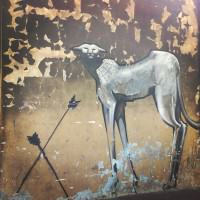
Graffiti is generally an illicit or prohibited art form, which when combined with the frequently anonymous nature of graffiti, makes it inherently provocative. Graffiti is no gallery-selected piece, or municipal-funded art project, but the work of an individual who feels the need to make some sort of publically visible ‘statement’. The rationale for graffiti are numerous (see here) but true to all graffiti is that it is visible to a broad sector of the public, which, combined with its frequently provocative nature, makes it a very powerful medium.
In the City of Cape Town there is a fair plethora of nature-based graffiti with depictions of wild life, mountain-scape scenes, and commentary on conservation concerns dotted around the walls of the City. Here the need seems to be primarily a drawing-in of nature to the City, and a demand to engage in or be aware of conservation issues. The audience seems to be both the citizens as well as the authorities. There is a call for renewed engagement and energy from the people of Cape Town, and simultaneously a demand for a more accessible, integrated, available, and people-owned nature in the City. It seems to me it is just the kind of art in question here: the sort that raises awareness, support and momentum for urban nature and green spaces.
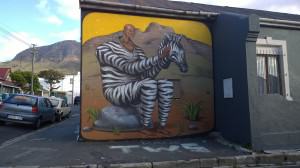
The question of how to make this art form a better catalyst for urban nature is a tricky one and probably comes down to a simple promotion of more of the kind of work already underway. Support in the form of legitimization could detract from the status graffiti has as ‘unsolicited public voice’ and ‘anti-authority’. Nature-based graffiti really takes both nature and art out of the realm of the middle-class and I think this aspect of graffiti is where the power and potential lies in allowing a different voice to enter a realm, certainly in Cape Town, that is often seen as elitist.
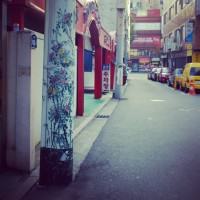
Perhaps what is needed is philanthropic support for those artists who work in this space. For example funded global exchange programmes, conversations between artists and ecologists, and nature-based graffiti art competitions, could all boost the scope and capacity of this community of artists. The difficulty here is that the anonymous and often transient nature of graffiti makes it unappealing to most funders who look for ‘bang for their buck’ with the kind of metrics unlikely to be found in an art work that must be anonymous, un-fettered, and might be erased overnight be vigilant anti-graffiti authorities. I think the dividends however in reaching many people are high, but not captured by standard metrics.
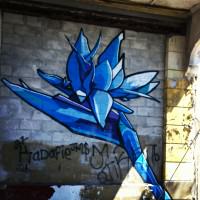
It would seem that the volume of nature-based graffiti in the City of Cape Town is somewhat higher than in other cities around the word, and it is possible there is something South African going on here. A long history of anti-government sentiment, and an associated disregard for authority, a pride in taking action, the circumstance of a country with significant natural biodiversity, and the process of giving voice to the voiceless might be a combination that is a South African legacy.
So a final note on how to sustain and grow this informative art form would be to foster these elements of civic engagement, especially among the youth where a natural inclination to rabble-rousing could be put to good effect with ongoing exposure to nature to develop a sense of custodianship which would in turn inform creative and artistic outputs.
about the writer
Marielle Anzelone
Marielle Anzelone is an urban ecologist whose work centers on people’s daily connections with nearby nature and the role that design, education, and government can play in fostering this relationship. She is the founder and executive director of NYC Wildflower Week—an organization that produces cultural and educational programming to engage urbanites with the wilds of the Big Apple.
Marielle Anzelone
I’d like to be able to say that I was inspired to create a public art project for lofty reasons. To reconnect urbanites with nature, for example. Or to build more habitat for wildlife. And while these elements are fundamental to the project, the actual catalyst was much less prosaic.
The inspiration for my art was frustration.
Our cultural zeitgeist has a design fetish. We swoon over celebrity architects and devote television shows to fashion designers. Anything transformed by human hands is deemed cool and sexy, including built landscapes. Cities are a favorite canvas because they are defined as lacking nature. Here landscape architects, among others, are keen to conjure urban forests, introduce native wildflowers, and restore ecological function. But cities are not a clean slate. Not even New York City.
It is easy to forget that modern New York City exists because of the abundant greenery that once defined it. Early Dutch sailors reported being disoriented by the scent of wildflowers wafting out to sea from Manhattan. Certainly no one has that experience today.
And yet, amazingly, forests, marshes and meadows have survived. Today, natural areas cover nearly one-eighth of the Big Apple, more than any other city in North America. Despite this rich natural heritage, New York City’s iconography is limited to taxi cabs, the Empire State Building, and Jay-Z—all hardscapes and humans. With nature excluded, original green spaces get little funding or attention and worse, are often threatened with development.
New York City’s natural areas consist of wildflowers, insects, soils, trees, sedges, and birds that evolved in situ over thousands of years. That kind of complexity is impossible to mimic in a built park. Red oaks brought in from nurseries in Michigan have different genotypes than our extensive local populations. In the drive to make their mark, designers largely overlook opportunities to support what we already have.
For example, the Red Admiral butterfly is a migratory species and pulses of them flock through New York City every spring. The same is true of other insects and many birds. Large natural spaces provide a mosaic of habitats to sustain a variety of wildlife. The trouble is no one designs with this in mind. When local forests are lost to ball fields or big box stores, all of that is lost too.
The problem is further compounded by location—reserves of open space tend to be far from our everyday lives—and out of sight is out of mind. The lack of civic interest in local conservation issues gave me an idea. To spark the public’s imagination, I needed to introduce ecology into the dialogue of urban design. My solution is PopUp Forest: Times Square.
PopUp Forest: Times Square will give visitors an immersive natural area experience in the most iconically un-natural place on the planet. We will transform a public plaza in Times Square into a large-scale temporary nature installation. Filled with towering trees, native wildflowers, and mosses and ferns underfoot, it will bring a piece of wildness to the heart of Manhattan.
The installation will feature guided woodland walks, interpretive signs, and hands-on educational activities. It will provide habitat for migratory springtime warblers and vireos and Red Admiral butterflies. Street noises will be muffled, and wildlife sounds will be piped in live from nearby woods. Then after three weeks—it’s gone.
This full sensory experience will open our eyes to the wild elements that share our urban home. I want this art to not only encourage people to rethink the way we aim to ‘green’ New York City, but also shake up our ideas of what cities ultimately can be.
Click here to learn more about PopUp Forest: Times Square. Or contribute.
about the writer
Stephanie Britton
Stephanie Britton is the founding Executive Editor of Artlink magazine, the visual arts quarterly established in 1981 in Adelaide, South Australia.
Stephanie Britton
Algae hacking, the Plastiphere and living off thin air
Artists who make work dealing with the natural environment do this sometimes in galleries with installations about water use, plants, forestry, loss of habitat, species extinction etc. The context of these installations is crucial to their knock on effect. If they take place in a typical precious white cube space the effect is minimal. If in a regional or less polished space they have more impact as a wider range of people actually see them, and the discussion framework around them is more likely to involve other artists, biologists, gardeners, activists, ecologists and lead to fruitful synergy and collaborations. White cube installations are seen first as a commodity on sale to a collector—whether that be a museum or an individual—and the ecological subject is the secondary message that comes through. Despite the fact that the artworks are laudable and interesting they are all too often limited to being attractive things with plants and water—with or without olfactory or tactile elements—rather than a means of opening up of new awareness and effecting change.
An example of the opposite was Michael Harkin’s piece at Bendigo Art Gallery in the state of Victoria, Australia, which used the town water supply data flow to reveal how much water was being used in real time by the citizens of this medium sized Australian city. The fact that it was created towards the end of one of the region’s longest droughts provided the element of urgency, and the uncomfortable sensation of witnessing the casual waste of the precious water that remained in the dams. Visitors to the Gallery stood spellbound in front of the endlessly changing data display which was sensitive enough to reveal when taps were turned on and off, toilets flushed, washing machines set in motion. The electronic sequences were translated into a work of sound and light playing on elements in the gallery suggesting traditional water tanks.
Guerilla gardens have sprung up in Sydney and Melbourne and other cities, and sometimes these are condoned, even supported by local councils, but often they have a limited life. There are examples of architects working with artists to realise works of public art which incorporate living green, but they are few and far between, and are either so abstracted that they are not perceptible as real plant life, or they are so fragile and vulnerable that they disappear after a short time.
Sustainability is the hallmark of the work of artist Lloyd Godman (who also writes in this collection of essays) who grows bromeliads which only need air to live. He has created large pieces of public art in Melbourne which hang in space or are attached to buildings, made up of these air plants. The difference between this and other attempts at greening the city is that they are designed to last indefinitely. The plants are capable of living for many years, and their slow pace of growth means that they become thoroughly self sustaining. The battle that such artists have to wage to persuade city managers to strike out into these domains of public art, can be daunting for most individuals in the West, where the public domain is massively regulated and controlled by layers of traditional thinking.
Working within a somewhat different set of parameters, Belgian artist Ivan Henriques has created a series of what he calls ‘Symbiotic Machine’ (SM) which engage photosynthesis in an intriguing way.
“SM is the creation of a prototype for an autonomous system that can achieve the basic needs of life: be able to find its own food to have energy to search for food again. This bio-machine hacks the electrons provided by the photosynthetic process that occurs in the algae spirogyra. This specific algae is abundant in the Dutch landscape—mainly found in ponds and canals—a filamentous organism that releases oxygen during the photosynthetic process, in turn creating bubbles which make this filamentous mesh of algae float.
“In order to ‘hack’ the algae spirogyra photosynthesis and apply it as an energy source, the algae cell’s membrane has to be broken. The SM prototype was designed within the disciplines of engineering, biotechnology, art and design to accomplish a condition—to make photosynthesis to continue its life cycle (1), like a plant.” [1]
This kind of work, known as Bio Art, is breaking the boundaries of art and green thinking, where the very matter of biology and the definition of ‘plant’ is opened up so that machine and plant can become one, and not only can life be sustained by a symbiosis of the two worlds, but, in theory at least, this can be used to clean watercourses which have been polluted. Could this new frontier be a way of thinking about how self-sustaining ‘biological design’ could enter the urban fabric? [2]
Another Bio Art practitioner, Pinar Yoldas, (Berlin) proposes that the gyres of plastic that have formed in the South Pacific challenge us to contemplate the coming of a ‘Plastisphere’—an ocean zone in which a new species will evolve from the minute particles to which the world’s trash has been reduced by the action of the waves. This new species will have its own nature parallel to the plant and animal kingdoms.
“Scientists from Brown University and Woods Hole Oceanographic Institution recently came up with the term ‘Plastisphere’ to describe the transformation of our marine ecosystems into a human-made plastic soup that generates new organisms and new microbial reefs even on the smallest plastic particles. Pinar Yoldas moves from observation and documentation to speculation to present a colourful future scenario that has its origins in the past and will continue to run its course no matter what.” [3]
One might speculate what could happen if China’s fast tracking of ecocities from the ground up or adapting existing cities like Chengdu, were to take on board the inventive projects of artists working with self sustaining natural elements.
A life cycle with functions was idealised in order to program the machine and activate independent mechanical parts of the stomach: it has to eat, move, sunbath, rest, search for food, wash itself, in loop.
[1]—Ivan Henriques, ‘Photosynthesis, electric motor: the Symbiotic Machine’ Artlink Vol 34#3 “Bio Art: life in the Anthropocene”, Sept 2014, pp26-29,
[2]—Artlink Vol 34#3 “Bio Art: life in the Anthropocene”, Sept 2014, pp30-33[3]—Ingeborg Reichle ‘Speculative Biology in the Practices of BioArt’
about the writer
Pauline Bullen
Pauline E. Bullen, PhD, currently teaches in the Sociology and Women and Gender Development Studies Department at the Women’s University in Africa, Harare, Zimbabwe.
Pauline Bullen
I have recently moved from New York City where artists continually reclaim urban spaces marked by age, dust and dirt with dynamic wall art (graffiti or street art), performance art and more and their works are often found side by side with thriving community gardens, parks and playgrounds. Works appearing in varied venues, such as community gardens often facilitate interactions amongst people and between people and spaces, in richer, more spiritual and dynamic ways.
In Harare, Zimbabwe where I have been living for the past year, I have strolled through and driven past community flower, art and sculpture gardens and have had the pleasure of observing much that is astonishingly beautiful, such as the lavender and purple glory of the Jacaranda trees in September and October, and sculpture gardens open to the public such as one that exists on the grounds of the National Gallery which features large and dynamic works by artists like the internationally renowned Dominic Benhura, who captures forms and feelings in ways that are incredibly real. I however, have also noted a great deal of waste and neglect primarily as a result from misuse and divergence of public funds. As a result the majority of individuals and whole families scramble for clean water, not to water the beautifully manicured lawns that some are privileged to maintain but to feed them selves. With better regulation and use of funds, government commitment to provide jobs, accessibly clean water, improved roads and transportation system, more frequent and reliable garbage collection, a community clean up campaign to build awareness and co-operation amongst the people regarding the health benefits of clean and green (less toxic) spaces would perhaps then be impactful. There may then be more respect for areas, including rivers, which become garbage dumps. There might be less frequent fires—fires to burn garbage and fires indiscriminately set that destroy trees, shrubs and grasses but also chase out wildlife in order to feed poverty and hunger in this country with its 90% unemployment rate. Throughout Zimbabwe works of art appear in well manicured front and backyard gardens, in areas deemed to be “high density” and in villages in the countryside and it appears that the general population barely ‘see’ there significance or notice their presence as they scramble to survive.
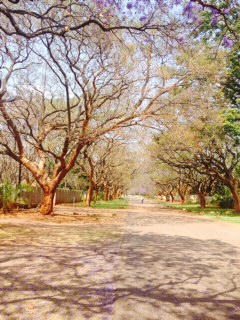 In the National Gallery of Zimbabwe there are permanent and temporary installations that demonstrate the creative and recreative nature of the people and speak to a number of current issues that trouble the community—gender based violence, child marriages and more. Permanent installations can also speak to a vision of a cleaner and greener urban center. A recent visit to one relatively small gallery in Harare allowed students to view landscapes commissioned by artists who were able to capture the varied nature of lands in particular parts of the country and the students were tasked to think about what scenes they, as artists, would want to highlight in their works—scenes that would not feed racist and voyeuristic ideas of a primitive Africa only suitable for safaris.
In the National Gallery of Zimbabwe there are permanent and temporary installations that demonstrate the creative and recreative nature of the people and speak to a number of current issues that trouble the community—gender based violence, child marriages and more. Permanent installations can also speak to a vision of a cleaner and greener urban center. A recent visit to one relatively small gallery in Harare allowed students to view landscapes commissioned by artists who were able to capture the varied nature of lands in particular parts of the country and the students were tasked to think about what scenes they, as artists, would want to highlight in their works—scenes that would not feed racist and voyeuristic ideas of a primitive Africa only suitable for safaris.
Another recent exhibition took individuals on a walking tour of the city to view original art works hung in varied and unexpected sites, a barber shop, the lobby of a hotel or government office, bus depots, supermarkets and more. It was said that, “artists were invited to submit an alternative reality through lens-based media”. In a huge plot next door to a shopping center I frequent, a gazebo was erected from recycled coca cola cans. There, works are developed from stone, wire, rubber, fabric and scrap metal, and all of these speak to a profound connection between the people, their surroundings and their fundamental need to provide even the basics for themselves and their families.
Projects like these and many more, may be adapted to interrogate the reasons for the deterioration of the ‘grey’ areas of the city and to promote the need for co-operative ‘green’ spaces.
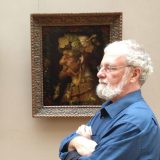
about the writer
Tim Collins
The Collins + Goto Studio is known for long-term projects that involve socially engaged environmental art-led research and practices; with additional focus on empathic relationships with more-than-human others. Methods include deep mapping and deep dialogue.
Tim Collins
Reiko Goto and I have moved back and forth from urban postindustrial sites to natural exurban sites in our art, ecology and planning practice for over thirty years. As artists we engage the world in cultural terms working with ideas, perception, experience and value. Current work engages plant physiology and the ecology of the human body as well as landscape. I would like to ask the reader to entertain the idea that urban nature has robust experiential value and can have eco-system authenticity but it primarily serves as a cultural ecology. Its power emerges in dialogue with images and media, narratives, scientific characterization and actual experience with exurban nature. The value of intimate daily experience and inter-relationship with nature cannot be minimized.
Living in Scotland these days I feel like Patrick Geddes and Ian McHarg are always nearby; they differ from others involved in landscape, art and planning through an essential interest in embedded and embodied experience rather than a distanced gaze, a visual relationship to the world around us. Below you will find a few thoughts from recent writing after spending a year working with the social scientist David Edwards and a group of scientists, land managers artists, humanities experts and resident community interests, thinking about an ancient semi-natural forest in the Highlands of Scotland.
A few ideas for a critical Forest Art Practice
—Establish a model for art with forests rather than in forests. Considering the process, method and form of art as ephemeral forest interface and as a correspondent image that works across the urban and the rural.
—Experiment with the idea of empathic exchange between people and trees, to consider the ways that trees and forest embody culture and how people embody the forest in daily life, regular practices or celebrations.
—Consider how art might contribute to the potential well-being or prosperity of a tree or forest community in the age of environmental change.
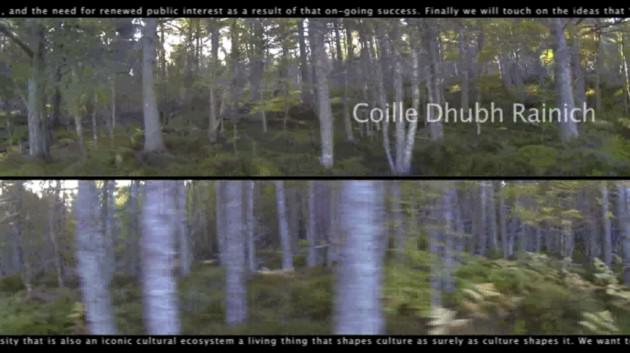
Thinking and being with the Black Wood of Rannoch, Scotland
In 2014, the Scots pine (Pinus sylvestris) was selected by the Scottish Government to be the national tree of Scotland, yet the social and cultural relationship to the Caledonian pinewood ecosystem is limited. It is neither an image nor a concept that has much traction in archives and museums or parks and botanic gardens in the cities of Scotland. It is an icon lost in time without a body or image for most urban Scots. As the southern-most large (only one of ten that are more than 1000 hectares) Caledonian pine forest, the Black Wood survived (where others did not) due to isolation and a lack of access. There is one road in and out of Rannoch on its eastern end, and a train line on its western end. Whether one arrives by train, car, foot or bicycle, most will struggle to find the Black Wood of Rannoch.
During the rut, nights in Rannoch resound with the calls of the stags, one quickly realizes this is a place where there are more deer than people (although this was not always trues.) There is one Forestry Commission sign identifying the Black Wood, it is easily missed, as it is set back and parallel to the Loch road. Another can be found a half-mile down a dirt road at the western edge of the Dall Estate. The Black Wood borders the southern shore of Loch Rannoch; between Dall Burn to the east and Camghouran Burn three miles to the west. To get into the forest one follows any one of four trails that move in a southerly direction. One enters the Black Wood moving gently uphill, the forest is alternately open and closed with a mix of birch and pine, and some rowan and juniper, all growing across a range of age classes from saplings to mature trees. The most memorable trees of the Black Wood are the 200-300 year old ‘granny pines’ with their sprawling limbs. One is immediately struck by the forest and its relationship to a curious topography; a mix of small glacial ‘moraine’ deposits or hillocks with a never-ending repetition of smaller hummocks of thick blaeberry, cowberry, bracken and heather. The hummocks are vegetation formed over large rocks and tree stumps, creating an unusual ‘lumpy’ forest floor that adds texture to the rolling mound-and-hollow topography. But it is the granny pines that are worth talking about: why are they here and why so many of them? What is the relationship between these broad branched trees, and the traditional foresters’ ideal of a tall straight trunk?
Moving through the forest along the western-most trails the casual walker will notice changes to topography, the small hills and valleys of the moraine field. This can also be understood as wetter and drier areas. Walking in a southerly direction (towards the summer hill pastures of the transhumance) the forest opens up to the south, where a bog is clearly visible through the trees. Those that explore that area will discover the remnants of an old homestead site on higher, drier ground. Moving further east along the trail, the casual observer will realize that the understory changes significantly with wetland grasses replacing the robust blaeberry and cowberry understory, in reaction to the increasingly wet ground underfoot. Further along the (raised and dry) trail, there are two spots where small open streams are first heard, then seen. These wet/dry transitions do two things. They provide a gradation of microhabitats that support a range of species. But they also provide an aesthetic complexity, which rewards the eye and ear, the nose and the kinesthetic (bodily) senses of those that walk attentively through this amazing forest. The east-west route through the eastern edge of the forest reveals more wet-dry transitions that can be appreciated from a dry trail.
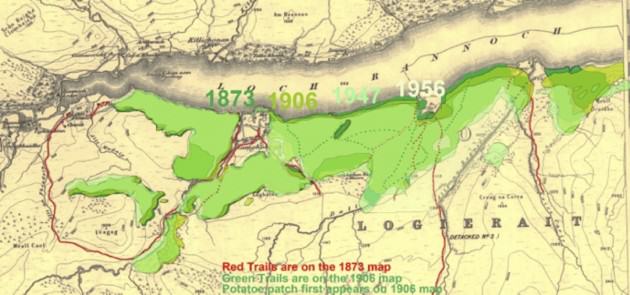
To understand the Black Wood one has to grasp the past, present and future in terms of the 300-year life cycle of a Scots pine tree and its relationship to the use of the land across that period of time. In the historical map above we can see an overlay of edge-to-edge mixed ancient semi-natural forest cover in 1873, 1906, 1947 and 1956; represented through color transparencies. The map tells us three important things. First the Black Wood has been resilient over this period of time, and regenerates despite losses. It establishes that some trails existed prior to 1873, while others were not mapped until 1906. Finally the dark spot at the centre of the forest, an area known as the ‘potato patch’ (by locals and the Forestry Commission ecologist), and attributed to war-related food production in the first part of the twentieth century, was actually cleared by 1906, apparently for some other purpose. The potato patch is notable today for its broad stand of commonly aged trees that reads like a plantation, straight and tall with little understory diversity. It provides an aesthetic counterpoint to the rest of the forest.

What we are trying to establish here is that the Black Wood is a powerful aesthetic presence. We argue that it ‘returns ones gaze’, or that it is woodland of sufficient complexity that it cannot be seen in a day, and indeed evolves in one’s eye and mind as it is visited over seasons and years. The Black Wood contains nested layers of wildlife, plant and microbiological diversity, that starts with the topography and soils, which are then followed by understory plant life, and a wide age-range of trees, some that are less than 100 years old, some that are more than 250 years old. In the layers of organisms, divergent reproduction cycles and ever-changing seasonal conditions lies a complex aesthetic experience that repays attention over time. But what is important here is this is a form that emerges from three centuries of conflict, beginning with the Jacobite rebellion and the forfeiture of the land in 1692, 1715 and again in 1745. In the middle of the 18th century, experiments with sheep would displace people as half the population was forced off the land in Rannoch Glen. Experiments with deer fenced into the forest would further shape the form, as would the eradication of the Gaelic language, which was still dominant in the decade before the dawn of the nineteenth century, and largely lost by the 1960’s and 1970’s. The dominant hill in the area is Schiehallion, or Sìdh Chailleann the fairy mountain of the Caledonians.
In a recent publication the Edinburgh Landscape Architect John Murray explores the contemporary value and import of the Gaelic language and its relationship to landscape; he talks about ‘ground truthing’ the biotic and the cultural. He says, “…at a fundamental level, the landscape is composed of physical, biological, and cultural elements.” But he also argues that landscape is imaginary and “…shaped in part by our perception and the values prevailing in society and cultures at the time” (Murray 2014, p. 208). Considering Gaelic place names, Murray reveals the fundamental interdisciplinarity that is embedded in knowing a place on foot and in the refinement that emerges during the exchange of everyday life. This is the model of experience and knowing that I want to consider in closing.
With any talk of the future, it is essential to recognize the past. With any talk of urban nature, we must reference the exurban. It has not always been clear that the ancient semi-natural forests of Scotland would survive the industrial age. It is only recently that conservation interests have been able to establish policies and regulations that protect these ancient forests from the mischief of owners, managers and developers. The question that remains unanswered is what can be done to kick start the social and cultural ecologies of places like the Black Wood? How can we create new cultural interface to essential ancient exurban forests and how do win turn, develop meaningful urban forests that reference the larger cultural import of nature? Ultimately, can art and culture serve the long-term interests of the complex of inter-relational living organisms that are Black Wood? I don’t think the problem can be resolved by catalytic agency, I do think the problem may yield to diverse and sustained creative inquiry.
For more information see collinsandgoto.com also please visit, anthroposcenemanifesto.com
about the writer
Emilio Fantin
Emilio Fantin is an artist working in Italy on multidisciplinary research. He teaches at the Politecnico, Architecture, University of Milan, and acts as coordinator of the “Osservatorio Public Art”.
Emilio Fantin
What role does art play in society? What cause does it serve, and why? Let us consider artistic process but also the practice of art in public spaces. Artists working in urban public spaces, or in natural contexts, have an innately different approach from those work in the solitude of private studios. The latter group conceives and realizes works of art work by establishing a bilateral relationship with the canvas (or its equivalent). The inspiration of artists working in this way flows freely from their interiority onto the canvas without being disturbed or modified by the neutral context of the studio. No word or gesture interferes with it. But artists working in public spaces must deal with an array of diverse and uncontrolled quantities—with the agency of people, environment, soil, pollution, the weather and so on. The work is the result of a confluence and a collaboration with external elements that ipso facto imply an interdisciplinary approach. The artist must transcend ordinary boundaries of the discipline in order that his inspiration is not disturbed, but infused and elevated by the externalities of the context in which he or she is working. The circumstances in which the art of public spaces is generated must be assumed by the actuality and vitality of the artistic process if the external, physical world is to be rendered internal and a part of the work. For it is not possible have a sincere relationship with the “external” if the profound quality that links any being to the soil, to the trees, to the city, is unacknowledged. The analytic psychologist James Hillman says that places have a soul. He does not mean, by this, that places are solely defined by their historical, geographical and social characteristics but that each has a further and distinctive essence. Particular places have special qualities so that, for instance, churches and places of worship are frequently built upon themselves—in the same places—century after century. What is in evidence, here, is the correlation of the soul of the place and the purpose of the Church. Thus if I am invited to intervene in an urban or ‘green’ space then it is incumbent upon me to engage with the context of the place. Listening to the voices of the trees, the soil, and the people inhabiting a space is the sine qua non of the creation of meaningful art in public spaces. The recognition and respect of the essence of natural elements is what allows an artist to properly feel and integrate the soul of a place. So, in an urban context, “to see” is to capture the essence of a place through its atmosphere; it is to learn it through the messages and indices of the past, but also the future, that its architecture communicates. To “feel” the history and social configuration of a place is to read across its colors and geometrical forms. Only after having interjected himself into the soul of a place, is the artist able to act. Without compromising the inspiration or integrity of the work, its essence emerges. And as a consequence, whoever looks upon the installation or experiences the intervention will recognize in his or her very being, the inherent quality of the place. This raises awareness. I guess we can call “art,” anything that is able to consolidate the deep legacy of the soul of the place, or that supports the imaginary that emanates from it. Art is work that provides momentum to the humblest invention without prejudice.
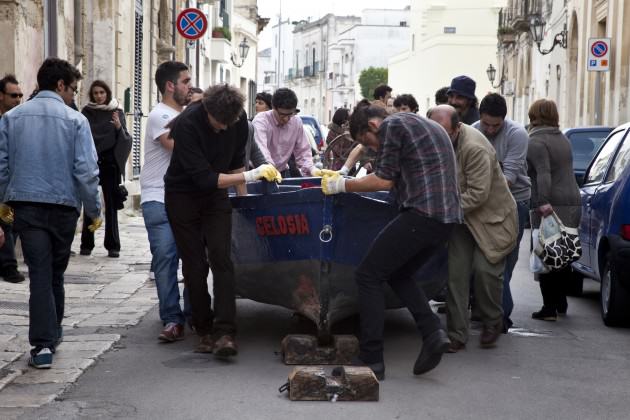
about the writer
Lloyd Godman
Lloyd Godman is one of a new breed of environmental artists whose work is directly influencing 'green' building design
Lloyd Godman
As a passionate gardener and photo-based artist in 1996 I made the connection that plants are actually a form of photography; both use the magical, mysterious ingredient that is LIGHT! In fact, the largest photosensitive emulsion we know of is the planet earth. As vegetation grows, dies back, changes colour with the seasons, the “photographic image” that is our planet alters. Increasingly human intervention plays a larger role in transforming the image of the globe we inhabit. Imagine foliated land as a photo-sensor (like a digital camera) that responds to light speeding past the planet. When we remove vegetation and replace it with buildings and infrastructure like roads, as in our cities, the materiality of the building becomes a “dead pixel” in the living sensor of the planet.
So in 1996, I began by growing images into the leaves of wide leaved Bromeliad plants and quickly the work evolved into complex interactive installations of Bromeliads suspended from the ceiling of galleries. Through studying the unique biology of these amazing plants I came to realize how they could adapt to the harsh conditions of a gallery’s air con system. I came to realize that using living plants in or as art transcends art as environmental comment and becomes art as an environmental action. In this I was inspired by Joseph Beuys’s 7000 Oaks – City Forestation Instead of City Administration, 1982 and set about to explore ‘art as active solution.’
Supported through a City of Melbourne Arts Grants 2013, Airborne was an acid test installed for 14 months in central Melbourne with no soil or auxiliary watering system. The work consisted of 8 suspended rotating air plant sculptures and withstood prolonged periods of dry and record heat, opening a portal for a new space plants could occupy in the built environment beyond the, roof top, beyond the vertical garden in what I termed Alpha Space.
As Bromeliads (Tillandsia is a Genus within the family) grow asexually, the living art works are super-sustainable, that is over time they can be harvested to provide a bio-resource to create new works. Unlike other artforms which often create more dead pixels in order to present their sustainable themed art, this super-sustainability is one of the truly unique characteristics of creating art with plants, and is especially so with Tillandsias.
As a means of retaining moisture, the highly evolved biology of Tillandasia uses a double photosynthetic pathway, capturing CO2 and releasing oxygen at night. They use tiny silver light reflecting trichome cells to absorb all water and nutrients through the leaf and can actually uptake heavy metals from the urban atmosphere.
At present I am carrying out an experiment with Tillandsia installed on four sites on Eureka Tower, the second tallest building in Australia at levels 56, 65, 91 and 92. If the experiment proves successful a larger project is planned which will open the way for installing plants in a creative but effective manner on super high-rise buildings.
Through the direct use of appropriate plants in their work, artists have the potential to occupy the largest of gallery walls and spaces in both a permanent and super-sustainable way, reach the widest possible audience and effect real change in the urban habitat. The walls, roofs and “alpha spaces” of our cites are the blank canvas of the 21st century, these are the spaces we must invade with our ideas and living green medium. Plants are a new (old) medium and one we must begin to use more often. By assisting plants to colonize the bare surfaces that are our buildings and the sky space between them in an imaginative manner, contemporary artists can evolve a blue print of urban nature and green spaces as fundamental as the discovery of single point perspective. If we turn to art action, future generations will experience this next millennium in a sustainably positive manner.
about the writer
Julie Goodness
Julie Goodness has a PhD in Sustainability Science from the Stockholm Resilience Centre at Stockholm University; her research is focused on urban social-ecological systems, functional traits and ecosystem services, environmental education, design-thinking and design-based learning, social action and community development.
Julie Goodness
I can still recall my first encounters with street art when I became a New York City resident; these small urban interventions of images or words always seemed like a personal entreaty, an invitation to reengage with an urban fabric made momentarily unfamiliar. I am still struck by the unique energy they generated within me; there was a sudden flash of inspiration to think differently about my role in the city or even take some kind of alternative action. Indeed, as Pippin Anderson details in this roundtable, I likewise think that urban graffiti and street art is one of the more provocative and universally accessible mediums through which we can engage our urban citizens.
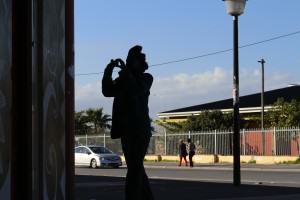
Lately, I’ve grown interested in how to propagate this feeling of inspiration and rousing call to action that I’ve found so satisfactorily embodied in street art. How can we spur our fellow city residents to make their own creative expressions and entreaties about their hopes for the city? One interesting possibility is participatory art, in which people can interact with and/or add to an existing installation, or are provided with instruction and materials to become the makers themselves and carry out their own artistic ventures. This is by no means a new concept, and may range from collaborative murals to data-driven exchanges (a favorite New York City example is Amphibious Architecture, which communicated information about fish presence and water quality in the East and Bronx rivers via SMS conversation).
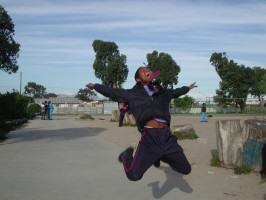
In my own exploratory attempt at participatory urban engagement, this year my colleague Katie Hawkes and I designed and pioneered Youth Design Studio, a sustainable design class for high school students that leads them through the process of how to research, design, and build projects for their community.
Hosted with groups of students in Cape Town, South Africa, the class was a project of the 2014 Cape Town World Design Capital, a year-long programme dedicated to exploring design as a medium for creative social transformation.
One of our lessons was a hands-on introduction to photography, in which we taught basic technical skills and demonstrated how the artistic medium could be used as a communication and storytelling tool. An ambition to have our students document the challenges in their communities (and therefore begin to explore their visions for possible creative intervention projects), led us to take a step back and give a more straightforward assignment:
Tell the story of your day-to-day life through the people, places, and things that are important to you.
What came back to us was truly powerful: beautifully composed images of family, friends, and objects of importance, but also very interesting depictions of connection to the urban nature of the city: the beach and ocean waves captured through a window of the schoolbus, or the sunset over a wetland in the informal settlement. One of our students expressly told us that his photographs told the story of his connection to nature and township life; a photo of a plant springing from a concrete wall (with the student’s shoe captured in the edge of the frame) spoke both of personal strength and of unexpected green flourishing in even the most challenging of urban environments.
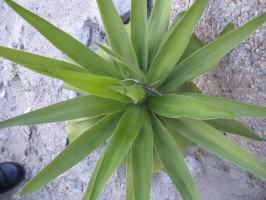
With another group, whose prompt was to convey how they felt when they summited Table Mountain in Cape Town on their camp trip, we received images of both victorious exaltation atop tree stumps, and quiet peacefulness nestled amongst vegetation.
While this exercise with our students just began to scratch the surface of what kind of stories they could tell through photography, it was an important proof of concept: even our youngest urban residents can use artistic expression to articulate important parts of their identity, and connection to both people and places in their community. While our students’ images do not explicitly advocate for urban nature and green space, I think they demonstrate the great potential available when we’re given the tools to convey what’s important to us in our urban worlds. I would argue that the first step towards raising awareness, support and momentum for urban nature will start with broader opportunities to equip and empower urban citizens with the tools (particularly artistic ones) to figure out who we are and probe our relationship/connection(s) to our urban environment. It is only through the critical reflection process involved these artistic explorations that we may eventually be inspired to become advocates and perhaps find new ways to communicate our visions for future cities of social and ecological well-being.
Thanks to the learners at Ikamva Youth Makhaza Branch, Muizenberg High School, and Beyond Expectations Environmental Program (BEEP), who shared their experiences through photography!
about the writer
Noel Hefele
Noel Hefele is an ecological artist who paints landscapes as entangled shared places. He lives in Brooklyn.
Noel Hefele
I find the terms urban nature and green space to be fluid and amorphous. I think the issue is our cultural relationship to nature (in ourselves, streets, buildings, parks, books, and minds) and not necessarily thinking of pockets of green space within urban cities. The boundaries of these terms leak and interact with culture in inextricably intertwined ways. Art definitely contributes to the values, aesthetics and interpretations of such cultural relationships to nature, yet perhaps the question should be flipped—How can we pay more attention and value the ways art supports, awakens, expands and challenges our relationship to nature?
I paint landscapes. Cezanne claimed that “The landscape thinks itself in me and I am its consciousness”, suggesting a temporary merging of subject and object. A painting then becomes more of a collaboration than a representation of the landscape; it does not claim to speak for it, rather, the landscape almost speaks through the artist, giving a visual form to the intangible connections between people and place. Painting is a response to a perceptual experience of encountering a landscape and making it visible through the body.
This appeals to me because it resists further objectification of landscapes and the inherent life and agency of non-human worlds. It opens up lines of participation for these landscapes to enter our cultural ecologies, almost like a tree branch or root growing more complex over time if successful, or dying if not.
Art has no measurable singular end goal; it creates multiplicities of experience and interpretation. It can push at the boundaries of our ideologies. A painting can teach new ways of seeing or what not what to see. A successful artwork can enter the vital flows of a cultural landscape, often seemingly taking on a life of its own, growing and changing over time. Catalysts do not seem to be afforded that same vitality; they are more utilitarian, while art seems to blossom into the world.
I learn as my paintings “find their way”, moving through and highlighting aspects of a previously unseen social fabric as people respond to them. Sometimes people share personal experiences of places I paint, adding depth and richness to my understanding of the landscape. It allows me a degree of awareness and access to a web of relationships that constitute a place. It is a folding in to the cultural and natural landscape that is both humbling and empowering. I paint landscapes that I inhabit and explore as a process of inquiry, never as an authority advocating for nature from a position of expertise.
Urban nature and green space (and Nature, for that matter) are terms defined by the cultural frame we put around them. My painting practice has taught me that the valuable aspects of such places come from tangled knots of perceptions and experience, human and non-human that constitute them.
I am interested in art that can contribute to the development of an ecological aesthetic of connectedness, social responsibility and perceptual tuning to environment. My hope for my own work is that painting and exhibiting landscapes I live in can foster a sense of connectedness within a whole, enhance a sense of place and intimacy, and call to attention a larger web of relations that we live in and among.
All of our interactions with nature are mediated through a cultural lens or transactional membrane. Work within any discipline that chooses to focus on nature or the more-than-human world contributes to the shape, scope and sensitivity of that membrane.
Returning to the question, one way to answer is for artists to recognize that the dominant issue of our time is climate change and all work is produced in relationship to that. But the question can never be answered in full—there is no direct cause and effect.
I frequently walk past a remarkable 142 year old Camperdown Elm in Prospect Park. It is a gnarled, horizontally growing, weeping tree encircled by a fence and held up in places with cables and various support structures. A plaque states that Marianne Moore, a Pulitzer Prize winning poet, captured the public’s attention by immortalizing the tree in a poem. “Moore’s efforts and those of a concerned group of local citizens succeeded in increasing public awareness about threatened and vulnerable elements throughout the park.” I’ve always held the impression that the poem saved the tree.
Is the tree nature, culture, or both? Unique conditions created the poem and the poems reception played a role in saving this tree. The emergent Friends of the Park organization had a role, the Camperdown’s resistance to Dutch Elm Disease also played a role; a series of disparate yet confluent actions all deliver this tree into the present. Perhaps the poem was a catalyst of sorts, taking advantage of a perfect set of conditions to make a difference and raise awareness for this curious tree. And yet, the tree, created through grafting and unable to reproduce on its own, was already dependent on culture for its very existence.
Art can create ( gather and express) a sense of alternate value and aesthetic appreciation for nature and our lived experience in the world. Culture permeates our landscape—we are in and of this world. When dominant value is monetary and context is climate change, the argument for the scientific, the practical, and the engineered necessitate answers from the arts and humanities who focus upon perception and value.
about the writer
Todd Lester
Todd Lester is an artist and cultural producer. He has worked in leadership, advocacy and strategic planning roles at Global Arts Corps, Reporters sans frontiers, and Astraea Lesbian Justice Foundation. He founded freeDimensional and Lanchonete.org—a new project focused on daily life in the center of São Paulo.
Todd Lester
Artists cultivating food systems
When I’m asked how Lanchonete.org is art by a curator, I often feel like it’s a test to see whether I’ll reference Gordon Matta-Clark’s FOOD, a restaurant the artist/ architect and colleagues started in lower Manhattan in the 1970. Sometimes I start my response with what differentiates Lanchonete.org from FOOD, or share the variety of influences—from French cooperative bistros to Welsh pubs, from Fast & French in Charleston, South Carolina made by artists, JEMAGWGA to the 70s Lanchonarte project by Brazilian collective, Equipe 3—that inform and inspire the making of Lanchonete.org. When folks from outside the art world ask the same question, I’m excited … excited to share these examples but also because the project’s personality and aspirations reach into a range of spaces and co-mingle with everyday life. While we are making the container, what happens in that space, and on the broader platform, can be authored by anyone, artist or not.
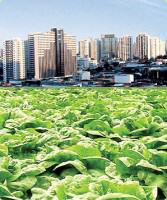
Lanchonete.org is the evolving, materializing result of both my artistic practice—one that is both research-based and curious about organizational form—and a process of community organizing by a group of diverse stakeholders, that includes artists yet not as a majority. This dual persona is what makes Lanchonete.org such a dynamic process, and I actually love how it doesn’t have to be understood as art by everyone who encounters it.
Given the topic of urban nature and green spaces, I immediately think of the urban sprawl and congestion of São Paulo, and how the municipal electric company, ElectroPaulo, is the primary holder of remaining green space—the space under power lines—in the city. Lanchonete.org is a five-year project, and in the first two years, our focus is on developing strong partnerships from key sectors and populations, which we feel are foundational to the project. These include both GastroMotiva (culinary vocational training) and Cities Without Hunger (urban gardening), which partners with ElectroPaulo in the East part of São Paulo where unemployment is at the highest level in the city.
GastroMotiva trains at-risk, urban youth to cook and become chefs in professional kitchens. Cities Without Hunger teaches households how to grow produce in urban conditions provides both a healthy diet and income-generating opportunities. Cumulatively the gardens under Cities Without Hunger management produce at a surplus; therefore it is possible for a restaurant to buy directly from producers. It shares a very similar ethos with GastroMotiva, to first improve food preparation and dietary habits at the household level that, in turn, leads to employment opportunities and holistic betterment in families, communities, neighborhoods, business and the city.
We plan to purchase our produce from Cities Without Hunger and hire our restaurant staff from the ranks of GastroMotiva trainees. Furthermore, we have asked the founders of both organizations to be part of an advisory council for Lanchonete.org, and are planning a hybrid ownership model whereby their organizations can serve as anchors within the association’s membership if so desired. Both organizations (whose stakeholders are primarily from the periphery) have expressed an interest in having a central location—or food/food service lab—in the Centro for a variety of reasons; therefore, its makes sense to enter discussions with them now regarding future usage and management of the restaurant facility.
{ii}
As you might imagine, I’ve been thinking about food systems a lot since starting the Lanchonete.org project in São Paolo these past years. In the same period, a steady stream of stimuli started coming my way. Over a year ago, the Vera List Center for Art & Politics presented programming entitled Your food is on its way, that focused—in part—on food delivery workers in New York City and how online aggregating services, such as Seamless, can result in longer delivery routes by offering the customer more options yet do not encourage higher tips to the delivery person. So whereas the customer perceives improved services, the delivery people, often informal, immigrant laborers, suffer lower earnings.
A friend told me about the international peasants’ movement La Via Campesina and its Food Sovereignty Principles; and most recently Thiago, a Brazilian friend in NYC, recounted his trip to Queens to visit the office of Tania Bruguera’s Immigrant Movement International, and witnessed some police stopping a food vendor out front and throwing away her food. The food cart generally and Thiago’s experience specifically remind us that we live in a time when the very cultural (by which I mean broader than artistic/creative) reference for a commodity becomes illegal. We’ve seen food cart primacy (foodie hype, rodeos and other gimmicks) literally supplant the middle ground—and important space—of food workers and delivery person rights while at the far end of the agency spectrum, immigrants in Queens who depend on informal labor (selling food) as their sole income can have the product (and representation) of their labor literally destroyed. Food carts and other pop-up notions, of course, play into the speculative real estate (capitalist) force that influences many—even well-meaning—urban plans that give us the new green and pedestrian spaces in NYC’s higher income zones (e.g. Madison Square Park, Prospect Park) where the food carts are allowed, stationed, taxed and begin to atrophy (because in effect they lose their original mobility/flexibility when sequestered in these demarcated zones).
{iii}
I’ll stop here without attempting to fully compare and contrast the urban nature and green spaces of NYC and São Paulo. There are many commonalities and many differences, which I look forward to discussing. In the mean time, here’s a survey of projects—old and new that I’ve come across in my research:
{Projects by and with Artists}
- El Matam El Mish-masery (El restaurante no egipcio) (by Asunción Molinos Gordo).
- Vacant Acres Symposium (Meeting of land transformation advocates from all over the world by 596Acres)
- Taste of Freedom (by Felipe Cidade @ Art in Odd Places)
- El Internacional & Food Cultura Foundation (by Miralda)
- Acarajé + Gravura (by Thiago Goncalves)
- Doris Criolla (by Amilcar Packer)
- Foodshed (by Smack Mellon)
- Eat Art (by Daniel Spoerri)
- Guia san Pablo
{Places / Place Concepts}
{Canada Resource Guide}
- Plant Adoption, a project that relocated city plants from areas with a wealth of fauna to poorer neighbourhoods that are often neglected by the city (by Golboo Amani).
- Poster-Pocket Plants, a project that integrates nature into the urban setting by creating pockets in existing posters throughout the city to create spaces for plants to grow (by Shawn Martindale in collaboration with landscape architect named Eric Cheung).
- Outside the Planter Boxes, a project that focuses on transforming crumbling city planter boxes (by Shawn Martindale).
- A Campus Food Revolution at the University of Guelph (in edible TORONTO)
- Cities Feed Cities: Unearthing three unique urban agriculture projects in Montréal, Toronto, and Vancouver (in SPACING)
- Local Food Map – Guelph Wellington (tastereal.ca)
{NYC Resource Guide}
- Delivery City: New York and its working cyclists (film)
- Chinese Staff and Workers Association
- National Mobilization Against Sweatshops
- New York Communities for Change
- Restaurant Opportunities Center
- Fast Food Forward
{Misc / Projects / Organizations / Initiatives / Articles}
- Sustainable Food Systems (Topos Partnership)
- Street Vendor Project (Urban Justice Center)
- Pesticide Action Network of North America
- Sustainable Development Institute (Liberia)
- World Botanical Research Associates
- Politics of Food (by Delfina Foundation)
- Organic Consumer’s Association
- SEED: The Untold Story (film)
- Rocky Mountain Seed Alliance
- Hudson Valley Seed Library
- Fechado Para Jantar
- Seed Savers Exchange
- Center for Food Safety
- Iroquois Valley Farm
- Inspiration Kitchens
- Change Food
- Slow Food
about the writer
Patrick M. Lydon
Patrick M. Lydon is an American ecological writer and artist based in Korea whose seeks to re-connect cities and their inhabitants with nature. He is an Arts Editor here at The Nature of Cities.
Patrick M Lydon
The lasting effects of an artist’s intuition and interactions
Two thoughts come to mind here. These thoughts likely stem from my getting to know artists who have such practices as I develop my own, and from my serving as an Arts Commissioner for the city of San Jose a few years ago, where public art commissions were large, and typically aligned with either ecology or technology as a theme.
The first thought is regarding the role of intuition, and the second is a note on materiality.
Most artists are likely to tell you that when they approach their work, they are not in a state of rational thought, but something we might call ‘intuitive’ thought—intuition is actually a rather poor word for it, but it is the closest most have come in the Western vocabulary.
The meaning of ‘intuition’ for me here, is one of place, earth, and spirit being connected well enough to serve as a primary guide for one’s actions. The luck of the artist’s position—and at times the curse as well—is that they tend to work in this intuitive state of mind as a matter of habit.
It is in this state of mind that the artist, as well the ecologist, the city planner, and others who seek to be truthful to their position as living beings on this earth, can meet and take deep and meaningful action together. This sentiment underscores a general need for development of an ecologically-connected mindset, for everyone.
So how does this help us create nature-awareness-catalyzing art? A primary application would be helping those who are involved in the propagation of a city’s structure—or in patronage of arts within this structure—to see the innate connection between an artist’s socio-ecological intuition, and the development of a vibrant nature-connected city.
Connected to this first point, is the rather difficult process of ridding ourselves of a very constricting requirement we often press to the artist, the requirement that they produce a physical icon.
Of course a great sculptural work situated well can fuel wonderment, connection, and intense depth in our experience of the nature and city which surrounds it, and it can be a catalyst in its own right. The work of James Turrell and his “Skyspace,” such as the urban situated “Twilight Epiphany” in Houston reverberate in my mind here as beautiful, meditative works which help connect us to this expanded consciousness.
Yet, in the shadow of such works, I believe it is critically important to also recognize—especially if we are to be mindful of nature and ecological working habits—that physical pieces needn’t always be case and point for urban art. Works such as the “3 Rivers, 2nd Nature” by Tim and Reiko Goto-Collins provide such an example in their use of community involvement to transform long-term plans for a city’s ailing rivers. In my own experience during a residency last year in Japan, I assembled a team to create a requisite temporary installation, however I think we all considered the legacy of our work to be the forging of long-term relationships between regional sustainable farmers and local community members.
Cities have a need for artists who make it a part of their practice to be change-makers, artists who make it a part of their practice to respond to the city, to its people, and to its built and natural elements. There are artists on this very panel who are exemplars of this, and many more throughout the world from Suzanne Lacy to Newton and Helen Harrison.
If an artist’s intuition and interactions can plant seeds in our minds, then the true importance of the artists’ work may at times lie more in a legacy of actions within the community which grow, shoot, and blossom from these seeds, rather than a tombic legacy of a finished art piece they might leave behind.
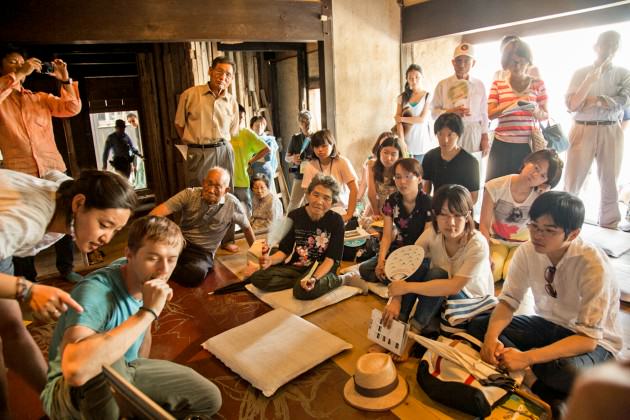
about the writer
Elliott Maltby
Ms. Elliott Maltby, founding partner of thread collective, definer of the urban backstage, iLAND board member, lover of novel landscapes, fisherwoman.
Elliott Maltby
In the light of the latest dire UN climate change report, perhaps we should be asking how art can catalyze and be action ; dramatic change in human behavior and our relationship to the environment is a necessity at this point. It should not be the role of the arts to simply weave a more compelling story with the facts that science provides, though there remains a need for that as well. But it is clear that knowledge and awareness alone do not serve as sufficient catalysts for change. I definitely don’t pretend to have the answers, but here a few ideas from my work with thread collective and iLAND*:
collaboration
At its core, the field of urban ecology is multidisciplinary; art can take advantage of this rich condition, developing new ways of researching, communicating, and exploring solutions. Over the years iLAND has developed a specific approach to collaboration across disciplines, rooted in the practices of dance and kinetic understanding. Bringing together movement artists and scientists, visual artists and designers for an intensive two week residency to explore an aspect of New York City’s urban ecology, we support the intersection and invention of different modes of knowledge. Over the years. we have created an adaptable framework for collaborators to participate in each other’s methodologies—and further, to develop new hybrid practices and research strategies that are locally calibrated. Some of the most profound insights have emerged from instances when an expert in one field allows themselves fully the experience of being a beginner in another. This mode of working also breaks down specific hierarchies of knowledge and allows for tremendous cross fertilization.
Deep collaboration requires risk, and the willingness to inhabit odd and unfamiliar situations. This can lead to entanglements, frustrating [but ultimately productive] miscommunications, and slow progress, among other ostensible barriers, but it is the moving out of these entanglements that a creative realignment can happen. Collaborations of this type allow artists to develop new complex processes and research approaches to match the complexity of urban systems and dynamics.
embodied participation
There are very few spaces in our culture where developing new, or experimenting with, collaborative processes is the primary focus of research. iLAND residencies are not structured around the production of a performance, but are required to have a public engagement component. This can take many forms, but must have a kinetic or embodied aspect, and often actively folds public participation into the on-site research. And here is one of many places where my work as a landscape architect and my collaboration with dancers intersects—a strong belief in the power of the physical experience. The body has an intelligence of its own, one that both supports and contradicts cerebral understanding. thread collective’s recent proposal, Gowanus Field Stations, is an exploration of the ecology of the canal, through temporary public space installations dispersed along its length. Each field station creates a dedicated space for people to observe and engage with a distinct aspect of the canal: these discrete experiences create a shifting, composite, and embodied understanding of the area, and demonstrate the intermingling of human and natural systems.
the mysterious
Admittedly, mystery is an odd word in this context, and while I’ve looked around for an alternative, I haven’t yet found one. I want to posit mystery as a counterbalance to the didactic impulse that drives some art in the realm of urban ecology. I am captivated by art that transforms the familiar into the unexpected, and where there are intentional, intellectual spaces, gaps, and fissures for the audience to occupy and explore. Like embodied participation, these kinds of ambiguities allow for critical engagement and the construction of understanding, rather than simple reception of information, that I believe is necessary for action. And while there is much compelling research out there to share with a wider audience, access to information may be less of a challenge than the problems associated with too much information. Art can also uniquely address what is not known, or poorly understood, in relation to our environment—and in doing so, remind us of the limits and fallibility of our knowledge.
* I have also worked with Mary Miss, a panelist in this roundtable, on a number of iterations of her City as Living Lab. I defer to her to describe the successes and insights of this incredible project.
about the writer
Mary Miss
Mary Miss has reshaped the boundaries between sculpture, architecture, landscape design, and installation art by articulating a vision of the public sphere where it is possible for an artist to address the issues of our time. She has developed the "City as Living Lab", a framework for making issues of sustainability tangible through collaboration and the arts.
Mary Miss
City as Living Laboratory (CaLL), is a national initiative that we have spearheaded to establish a platform for artists, working in collaboration with scientists, urban planners, policy makers, and the public, to make SUSTAINABILITY TANGIBLE THROUGH the ARTS. CaLL asks: by what means can we foster roles for artists and designers to shape and bring attention to the pressing environmental issues of our time?
CaLL’s aim is to advance public understanding of the natural systems and infrastructure that support life in the city. Its strategies are grounded in place-based experience that make sustainability personal, visceral, tangible, and encourages citizen and governmental action. Ultimately, CaLL’s goal is to establish a FRAMEWORK that can nurture such multidiscipline and multi-layered teams in processes that bring about greater environmental awareness and envision more livable cities of sustenance.
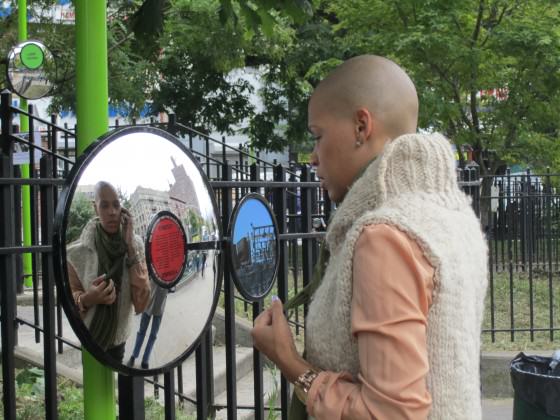 This FRAMEWORK is a process of inquiry and exchange between artists and designers, research scientists, municipal policy makers, local community groups, and academic partners. Activating the FRAMEWORK are projects and programs that seed sites, with installations, interactive activities, and events. While focused on the unique conditions of specific locales, the projects and programs are designed to set examples that can extend to other cities over time. These activities are conceived to nurture partnerships among disciplines, institutions, neighborhoods, and interested individuals as they work together toward shared environmental and sustainability goals.
This FRAMEWORK is a process of inquiry and exchange between artists and designers, research scientists, municipal policy makers, local community groups, and academic partners. Activating the FRAMEWORK are projects and programs that seed sites, with installations, interactive activities, and events. While focused on the unique conditions of specific locales, the projects and programs are designed to set examples that can extend to other cities over time. These activities are conceived to nurture partnerships among disciplines, institutions, neighborhoods, and interested individuals as they work together toward shared environmental and sustainability goals.
There are two major facets to CaLL. One is the continued development of PRECEDENTS by Mary Miss such as FLOW (2009–2013) and Stream/Lines in Indianapolis (2013-2016), and If Only the City Could Speak in Long Island City, NY (2011-12), and the ongoing Broadway: 1000 Steps. The second is the support of PROGRAMS that promote collaborations by other artist/scientist teams. This is done by identifying an artist’s interests and recruiting an appropriate science (or other expert) partner.
One strategy CaLL uses to advance these collaborations is its signature WALKS where teams engage the public in a dialogue that makes real conditions—past and present—along with speculative ideas for future visceral and tangible through place-based experience. Building on critical concerns that have emerged from its research and outreach for the Broadway project, CALL WALKS invite artists to respond to features and issues along the avenue through place-based dialogues. The outcomes of these walking dialogues are contextualized in panel presentations that include outside experts and observers and are hosted by collaborating institutions.
The WALKS start with an invitation to an artist or designer to consider a site or location and an issue of distinctive relevance to that site. Once an area of focus has been determined, CaLL works with the artist to find a scientist or expert who can provide a new set of resources—data, methodologies, learning goals, perspectives, applications, etc. The artist-scientist team is tasked to reflect on the appointed issues in public spaces, exactly where their ideas might help increase awareness and accelerate change. This phase of the challenge is purposefully set in places that are accessible and open to all. The initial artist and designer-led WALKS have engendered dynamic exchanges and sparked innovative strategies. The WALKS have been developed as both an interactive public engagement, as well as a means to vet long-term partnerships between artist and scientist team members.
Other steps include nurturing ideas generated by the WALKS or forwarded in community WORKSHOPS, and the commissioning of full-scale PROPOSALS or PROTOTYPES. The WORKSHOPS involve a selected number of artists and scientists who have participated in the WALKS. They are designed to generate ideas and tactics for innovation and change that emerge from community responses and reflections, while building a grass roots support base, for proposed projects.
The development of these PROPOSALS into PROJECTS to be incrementally implemented and to make new ideas about sustainability available in communities at street level as is at the heart of this initiative. The goal is that through these experimental methods, CaLL is building a replicable practice that sparks dialogue and promotes action for sustainable urban life through art/science/community collaboration.
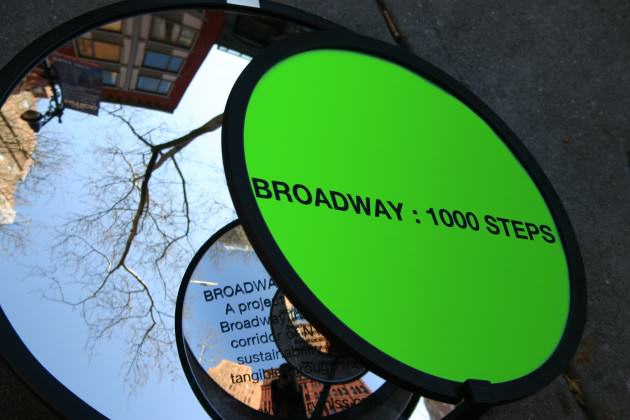
about the writer
Lorenza Perelli
Lorenza Perelli is an art historian, writer and artist living in Chicago. She taught Public art At the University of Architecture in Milan, with the artist Emilio Fantin. She is the author of "Public Art. Arte, interazione e progetto urbano", edited by Franco Angeli in Milano.
Lorenza Perelli
Do it yourself
The projects I discuss here are part of the recent debate on how art, architecture and design raise awareness to urban and natural habitat. They all are radical in the intention to foster a new reconciliation between nature, the city and the people who inhabits them. Abandoning the opposition between the nature and the city—heritance of some part of the ‘900 art and culture with its nostalgic theme of the ‘return to nature’—these projects work to bridge the human and natural habitats under the aim to make them more sustainable, accessible, and inclusive.
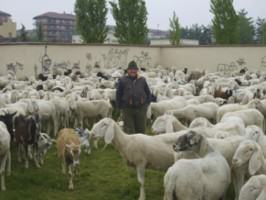
The City of Turin “saved 30,000 euros by using sheep to mow lawns at three public parks” with the project Pasture in the City, whom also “aerate and fertilize their temporary pasture”; 78th Play Street in Queens, New York, worked with the Department of Transportation to “close a one- block stretch of 78th Street off to cars in order to create a play space.” While the first is organized by the City of Turin in Italy, 78th Play Street is a “spontaneous intervention,” a ‘do-it-yourself’ method of urban planning. It is the new more modern economy of reuse and sharing. In other cases—like WHAT IF: projects Ltd. (Ulrike Steven, Gareth Morris) in the UK and Haye Valley Farm in San Francisco—artists and architect work with the community to reuse interstitial urban spaces for farming and food production. On these direct ‘creative’ use of participating practices, art merge with urban planning and design. Since the late Nineties, artists have worked toward a new paradigm of radical collaboration between the audience and the artist. A new idea of creativity is at stake: one where the artist, the urban planner or the designer is the facilitator or the creator of the connection between the community, the natural landscape and the everyday life in the city.
about the writer
Stephanie Radok
Stephanie Radok is an artist, writer, freelance editor and General Editor of Artlink magazine.
Stephanie Radok
Art is a space against conformity, rigidity and convention, a space of possibility and discovery, invention and creativity—an ever-renewing starting point for the ongoing development of human culture.
Art is always potentially a bearer of the conscious recognition of sharing the world with other life forms, animate and inanimate, past and present.
One way that art can be a better catalyst to raise awareness, support and momentum for urban nature and green spaces is by being outside or drawing attention to the outdoors of the city.
By being in the world outside galleries and museums and by commenting on daily life.
By taking account of the seasons, the weather and the time of day.
By being casual and ephemeral.
By being free.
By connecting to where it is rather than imagining it lives in no-place.
By connecting to the Earth in big ways.
By separating from the money story.
By being small.
To encounter art when you are not expecting it is to experience surprise and to lighten up, to be delighted. And that delight can be about other lifeforms that we share the city with.
I recall seeing a piece of paste-up art in the street on the post holding the button that people press to cross the street. It consisted of a small image of a pigeon and the text “you walk funny”. Is the pigeon talking to you? Does it have an opinion? A biography? As you cross the street you start thinking about how pigeons and many other birds walk—they sometimes bob their heads as they walk. You try it. You walk funny. You feel lighter. Next time you see a pigeon you see inside it a little.
Weeds of the City, an artwork I made in 2010 for a project called ‘Little weeds: small acts of tenderness & violence’ involved walking in the city of Adelaide every Sunday morning with my dog for a month. While we walked I photographed and then collected weeds from cracks between the pavements and the edges of the gutters. The collection sites and images appear on the website. The weeds are travellers, evidence of botanical diasporas from all over the world. I took them home and then painted images of them on beer coasters, Belgian beer coasters. Fine art is often painted on Belgian linen, in this case the cardboard was from Belgium. At the exhibition the weeds were on sale very cheaply and people were encouraged to buy two and then release one, set it free, in a city pub or café then photograph it and return the image to the city-mapping component of the website of the exhibition.
At the time I wrote: “I am starting to see the city differently from ground level, as both a refuge and a prison. This study of what grows wild and disregarded by the side of the road includes important herbs and edible plants. Among them are some of the seven sacred herbs of the Anglo-Saxons, wattle seedlings, ferns and mistletoe, grain plants, poisonous plants, edible plants. Is it possible that one day the knowledge of what grows disregarded around us may be the difference between life and death? This post-apocalyptic thought is hidden somewhere in the work. Even as the edges of our streets are poisoned so that weeds will not suggest a lack of control so rare plants are found on the verges of roads, escapees from homogeneity.”
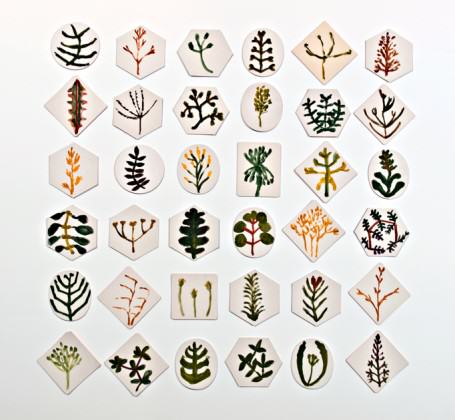
about the writer
Lisa Terreni
Lisa Terreni has been involved in early childhood education for many years—as a kindergarten teacher, a senior teacher, and as a professional development adviser for the Ministry of Education. She is also an artist.
Lisa Terreni
Knitting the faculty together
One of the courses I teach at Victoria University of Wellington for first year early childhood teacher trainees, called Well-being and Belonging, includes a module about the conditions that foster optimal learning environments (Terreni & Pairman, 2001). One of the students’ tasks is to participate in a joint photo voice project (Wang & Burris, 1997). Students individually document, with photographs and text, what they like and dislike about their own learning environment (the Faculty of Education campus), and identify ways to improve it. Once data has been gathered, the photographs and comments form the basis of an exhibition that is displayed in the student cafeteria. As it is a participatory exhibition, other students and staff at the faculty are invited to contribute by adding their own suggestions and comments using sticky labels which are added to the work.
The students’ photo voice exhibition in 2013 led me to consider a number of participatory environmental art interventions that could help ameliorate some of the drab greyness of the campus—an area of concern identified by students in their exhibition. Consequently, in 2014 I initiated a yarn bombing art project entitled Knitting the Campus Together. The project was motivated not only by the students’ critique of the campus, but also by a series of staff redundancies at the faculty which badly eroded morale. The yarn art that resulted, made mostly of recycled wool, involved many people—academic and administrative staff, as well as students. It was designed so that staff and students would work collaboratively to create art, but also to foster a sense of community as the work progressed.
Several knitting stations were set up throughout the campus, and knitting workshops were run for students. Once the yarn art was completed, it was installed in many locations around the campus. These added colour and interest to the environment, often complementing some of the buildings’ architectural features and highlighting the campus’s exquisite gardens. Through the process of their involvement in the project participants learned that domestic craft, such as knitting and crochet, can be used to create works of art that amuse, delight, and lift the spirit.
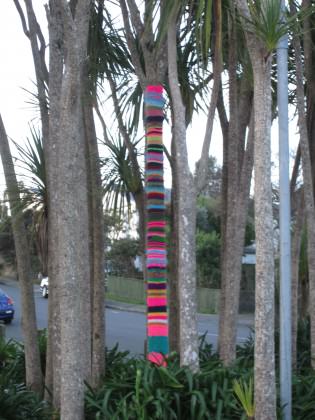 The yarn bombing project also sparked considerable interest from the general public. Children who pass the campus on their way to school were often seen hugging a yarn bombed cabbage tree. One of our administrators recently e mailed me remarking, “the appearance of knitting on poles and tree trunks has been a talking point for many and add pops of colour around the campus … When I was at my gym in Mana last week, someone discovered I worked at the faculty and talked of their joy of seeing the knitting around the campus”.
The yarn bombing project also sparked considerable interest from the general public. Children who pass the campus on their way to school were often seen hugging a yarn bombed cabbage tree. One of our administrators recently e mailed me remarking, “the appearance of knitting on poles and tree trunks has been a talking point for many and add pops of colour around the campus … When I was at my gym in Mana last week, someone discovered I worked at the faculty and talked of their joy of seeing the knitting around the campus”.
De Button believes that art, design and architecture “… talk to us about the kind of life that would most appropriately unfold within and around them. They tell us of certain moods that they seek to encourage and sustain in their inhabitants” (2006, p. 72). The students’ exhibition and resulting art interventions have had multiple benefits for the faculty. This work clearly demonstrates that exhibitions can create opportunities for reflection and ongoing debate, as well as generating ideas for change. Art interventions, such as the one described, provide opportunities for individual and collective endeavor that can uplift and inspire those who inhabit learning spaces like the Faculty of Education.
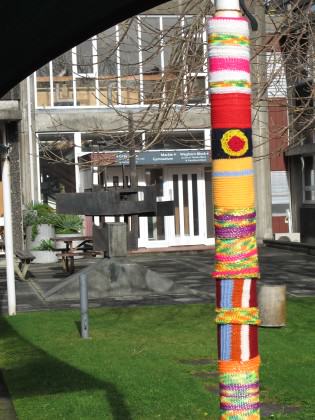 References:
References:
De Botton, A. (2006). The Architecture of Happiness. New York: Pantheon Books.
Pairman, A. & Terreni, L. (2001). If the environment is the third teacher what language does she speak? Retrieved from here.
Wang, C. & Burris, M. A. (1997). Photovoice: concept, methodology, and use for participatory needs assessment. Health Education & Behavior. 24(3): 369-87.
about the writer
Shawn Van Sluys
Shawn Van Sluys is the Executive Director of Musagetes, a foundation that makes the arts more central and meaningful in people’s lives.
Shawn van Sluys
Art and Urban ‘Blue’ Space in Rijeka, Croatia
I want to take a slight detour from the question to talk about urban “blue” space: how art relates to the bodies of water along which our cities are built—especially seas and oceans.
Since 2010 Musagetes has been working in a small, post-industrial city at the top of the Adriatic Sea called Rijeka, Croatia. Rijeka’s waterbreak pier has been shielding the city from the sea since 1888. As property of the Croatian Port Authority the pier enclosed a functioning harbour for ships and fishing boats until it was decommissioned for customs purposes in 2008. As part of a commercial port—one of the largest in Europe up to the turn of the twentieth century—the pier runs the length of the city centre, anchored on the east by a new cargo port and a small cove for ship maintenance; and on the west by silos, a defunct torpedo factory (the weapon was invented there), a rusting INA oil refinery, and a large shipyard called 3.MAJ.
In 2008, the port authority and the City of Rijeka opened the gate where the pier begins and stepped aside to see what would happen with this new almost-public space. As a former industrial site, it had all of the rough intrigue of rust, concrete, ropes, rubbish, and fishnets. Over months it slowly emerged in popular consciousness that this foreign space could now become familiar—as familiar as the ubiquitous lovers snogging nightly in the shadows of the concrete berm. Whereas the pier had once been an icon of productivity, progress, and connectivity, it became a symbol of the city’s transition from being a regional—Yugoslavian—industrial centre to being a small struggling city facing global economic and social crises. This is the context within which Musagetes first visited Rijeka.
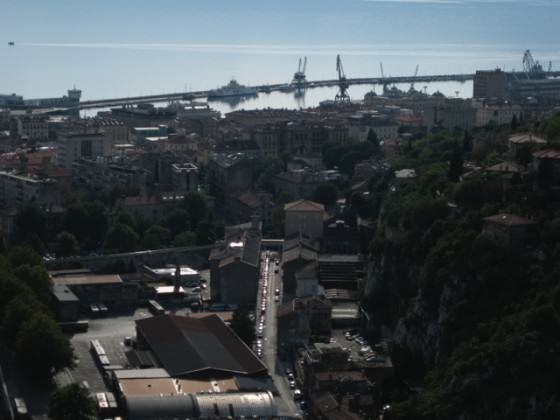 As we explored Rijeka we found it to be a city simultaneously nostalgic for the material production that marked its industrial history and aware that a new rhythm, a new pattern, can emerge from the possibilities promised by transition. The pier is a metaphor for a struggling city boldly seeing itself anew—in the words of Canadian poet Ross Leckie: “Metaphor is a form of knowing, a way of seeing-as, and from this everything follows, all of our possibilities for ethical and political thinking and being, and certainly our possibility for grace.”
As we explored Rijeka we found it to be a city simultaneously nostalgic for the material production that marked its industrial history and aware that a new rhythm, a new pattern, can emerge from the possibilities promised by transition. The pier is a metaphor for a struggling city boldly seeing itself anew—in the words of Canadian poet Ross Leckie: “Metaphor is a form of knowing, a way of seeing-as, and from this everything follows, all of our possibilities for ethical and political thinking and being, and certainly our possibility for grace.”
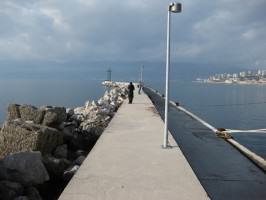 The pier, as a new public space, is literally a new place from which to view the city and therefore a new way metaphorically to see the city. The storied pier lurks in local consciousness as an object of mystery, as something familiar but with so much yet to reveal. The emergent and abundant creative potential embodied by the pier-as-metaphor became the nucleus of Musagetes’ artistic program in Rijeka in 2011 and 2012.
The pier, as a new public space, is literally a new place from which to view the city and therefore a new way metaphorically to see the city. The storied pier lurks in local consciousness as an object of mystery, as something familiar but with so much yet to reveal. The emergent and abundant creative potential embodied by the pier-as-metaphor became the nucleus of Musagetes’ artistic program in Rijeka in 2011 and 2012.
The first artist we invited to intervene on the pier was Laetitia Sonami, an Oakland CA-based sound-instrument inventor and a creator of immersive sonic environments. She has, and encourages others to have, a ‘sonic curiosity’ in the form of ‘sonic harvesting’—an approach to field recording and an inquiry into the social, historical, and political contexts of the ‘harvested’ or recorded sounds.
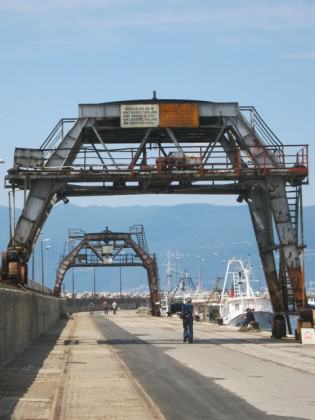 Sound Gates (2011) was the first artistic installation to animate the pier in its post-industrial state. Laetitia reimagined the bases of the defunct ship-loading cranes as symbolic gates welcoming residents to the new public space. She installed and camouflaged four homemade speakers—made of aluminum buckets and simple electronics—on each corner beneath the crane structures. An audio player was connected to motion sensors and a random selection of sounds quietly emanated from above when walkers activated the sensors. The volume was subtle enough not to startle but just loud enough for passersby to become vaguely aware of the presence of the sounds. After a moment listeners became fully conscious of, and then transfixed by, the sounds.
Sound Gates (2011) was the first artistic installation to animate the pier in its post-industrial state. Laetitia reimagined the bases of the defunct ship-loading cranes as symbolic gates welcoming residents to the new public space. She installed and camouflaged four homemade speakers—made of aluminum buckets and simple electronics—on each corner beneath the crane structures. An audio player was connected to motion sensors and a random selection of sounds quietly emanated from above when walkers activated the sensors. The volume was subtle enough not to startle but just loud enough for passersby to become vaguely aware of the presence of the sounds. After a moment listeners became fully conscious of, and then transfixed by, the sounds.
The power of sound lies in its potential for displacing the ordinary—its immediacy in our consciousness and its gradual lending of coherence to our understanding of place. The sounds ‘showering’ from Sound Gates were a combination of voices—conversing, singing, laughing—and recognizable sounds of the city—of metal in the shipyard, church bells, the bustle of the Korzo, and the creaking of swings in the playground. Sounds are also strongly connected to memory, reminding us of events in the past that were once familiar.
The pier became a liminal space, reconnecting the city to its urban blue space. An ongoing program of artistic work on the pier opens a new poetic relationship between the residents and their city and their sea.
Laetitia herself observed: “I came to think of the pier as a double-sided mirror, reflecting the city and its rich industrial heritage—its sounds and voices—and also a projection space onto the open Adriatic sea, gazing outwards.” Her second project on the pier, titled Invisible Sea (2011), did exactly that: it was an oculus for sonic ‘gazing’ at the sea.

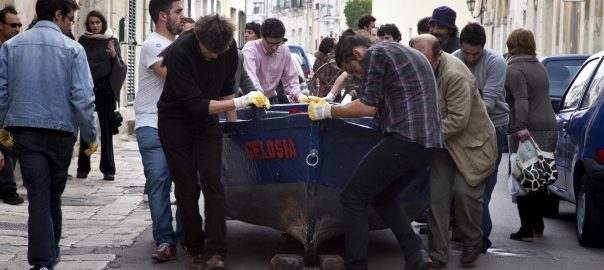






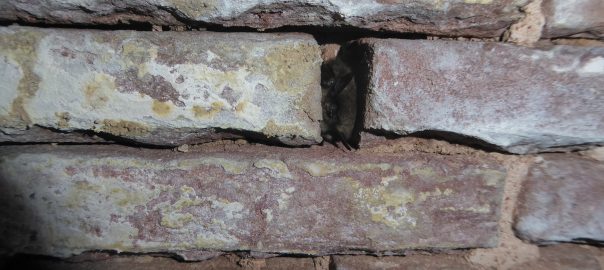
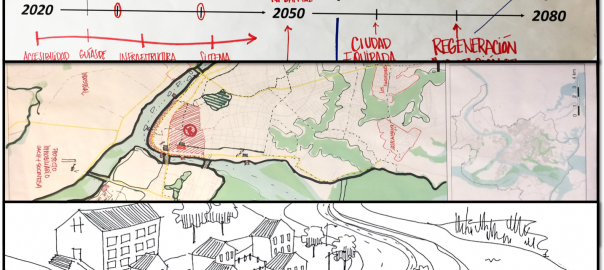

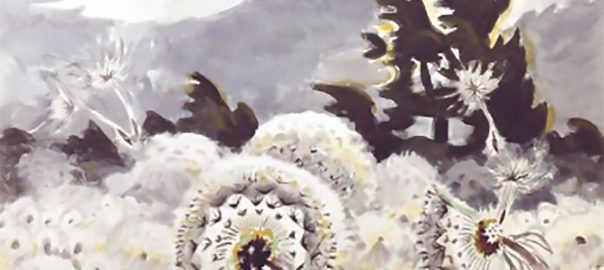
Greetings – inspiring work and conversations
Using aesthetics as a decision point can be dangerous, but I would say this this is true only if we assume that our collective level of aesthetic judgement has a very narrow base (and admittedly, it generally does!)
Is a winter woodland devoid of green plant life ugly or beautiful? Does it ‘need’ to be brightly colored to be appreciated aesthetically? Could it be augmented with ‘art’ in order that we call to attention the inherent beauty in, say, decaying leaves, or acorns buried into tree limbs? Pippen made a great point on this topic below.
In the 90s in America, I remember metallic, parachute-like “MC Hammer” pants were judged as aesthetically pleasing. Of course, it took an artist, MC Hammer (and his PR staff), to create that view.
I suppose using the lens of aesthetics (and ethics to a similar extent) requires us to open up our view and acceptance a bit wider than we think is normal. Artists are generally quite good at putting that hat on.
“If an artist’s intuition and interactions can plant seeds in our minds, then the true importance of the artists’ work may at times lie more in a legacy of actions within the community which grow, shoot, and blossom from these seeds, rather than a tombic legacy of a finished art piece they might leave behind.”
I often get a sense of this tombic legacy when visiting museums where art can often be concretized into very specific meaning sets. I try to think of art as generative and vital, like a garden.
It is interesting to interchange your personal definitions of each. Try, for a day, to consider all art as you do greenspace, and all greenspace as you may understand art. The reversal helps me see what constraining perimeters I may have put around each concept.
I also find this fascinating about confronting and dealing with the “ugly” and the less pleasing aesthetics inherent in urban nature.
Of course, in the context that we’re dealing with here in this roundtable – inspiring support and momentum for green spaces in urban nature – I think our tendency is to lean towards the overtly positive and aesthetically pleasing connotations present in our work. Indeed, I think the majority of our posts and projects compiled here focus on the beautiful and the inspirational elements of urban nature.
The line of reasoning is easily derived: when a subject is cast in a positive light, it is easier to gain traction for it (an often-stated idea behind why fear-inducing statistics and narratives emphasizing impending global environmental catastrophe do not work to produce environmental actions nor solutions).
But I’m also worried about how overwhelmingly positive depictions might actually damage us in the long-term for gaining support for a holistic urban nature in cities. I wonder if some of our provocations should engage more purposefully with the dirtier, unkempt, and unclean parts of urban nature?
I am reminded of a documentary, “After Life: the Strange Science of Decay” (http://www.bbc.co.uk/programmes/b012w66t), that tracked, in detail, what would happen if you were to leave everything in your kitchen to rot. The documentary was produced as part of an art installation at the Edinburgh Zoo, in which a glass box containing a typical kitchen and garden was left to decay in full public view for two months. The exhibition took processes that normally cause disgust (most of us will quickly dispose of offending and moldy old food) and instead turned them into objects of contemplation and scrutiny, highlighting the necessity of these cycles for the very maintenance of life on Earth.
In a smaller-scale anecdote, I remember well the comment that came from a middle school student who was visiting the urban farm at which I volunteered, as I pulled carrots up from the soil:
“WAIT, carrots come from the ground?! They’ve got dirt all over them! EWW!”
With the majority of the world’s inhabitants now living in cities, we are certainly at risk of perfectly manicured promenades or sterile planters becoming the norm in popular conceptions of nature. These elements certainly fit with municipal-maintenance schedules and satisfy the historical imprints of the arrival of germ-theory to cities, but as Marielle, Pippin, and Paula remind us, they are censored ecosystems in the extreme, and often leave us little along the lines of ecological integrity and realism. In my own PhD research, examining which faunal and floral characteristics people select for and what ecosystem services they strive to maintain in cities, I often find myself grappling with the inherent danger of an exclusively anthropocentric focus- what if our immediate desires and preferences are not indicative of what is needed for long-term ecological sustainability? Considerations for trade-offs are certainly necessary somewhere in the equation.
Maybe part of our task will be pushing our urban residents a bit into the realm of the uncomfortable… to deal with the barren branches of deciduous trees, to actively handle the insects among the compost, and to tolerate some stench of decay. I’m not saying that we can’t exclude pleasing aesthetics entirely as part of experiment (even the whorls of the nastiest bread mold can be fascinatingly beautiful), but I think provoking urban citizens to embrace the entirety of urban nature – in all its gore and glory – will be an important topic to explore.
Keith Tidball also writes on a similar theme in his work about “Greening in the Red Zone”:
http://www.thenatureofcities.com/2012/09/30/greening-in-the-red-zone-thoughts-on-disaster-resilience-and-community-greening-in-the-peopled-landscape/
The City of Turin “saved 30,000 euros by using sheep to mow lawns at three public parks” with the project Pasture in the City, whom also “aerate and fertilize their temporary pasture”. This makes so much sense. Thanks Lorenzo.
This is a fascinating idea that you are fleshing out here, Pippin. The same could be said of the PopUp Forest – certainly in winter there is sparse beauty in our temperate deciduous woodlands, but most people prefer (exotic) evergreen shrubs. The installation is timed for June 2016 – spring is a very pretty time in a forest here. But the “ugly” is just as important. I think this goes back to the ideas of aesthetics that was brought up in an earlier comment. Aesthetic considerations can be dangerous, for many reasons, not the least of which is that they overlook ecological function.
I think starting with aesthetics as a basis for urban design or environmental art is problematic. It leads to anesthetized landscapes that have no ecological function. In most cases, biological processes could easily have been woven into the urban design fabric, but it never is. We are left with declining native pollinators and loss of wildflower habitat that could easily be part of urban daily life.
Thanks Lloyd – this Grasslands installation looks great!
Paula pertinent comments on how “Plants grow, flourish and give fruits! but also decay and dye, and that is also part of nature”. But not all plants die, plants like most Bromeliads grow a-sexually which means that while the old tissue of the parent plant dies the new growth continues through the next generation while still attached to the mother plant and becomes the next ramet. Theoretically these plants live forever.
Great Marielle cant wait to see it
at the Baldessin Press where I live we are connected through a residency to the Sate library so I got new of this project http://news.blogs.slv.vic.gov.au/2014/10/14/linda-teggs-grasslands-opens/#.VGOohfmUeSo
let me know when its happening so I can promote it through sm
Cheers Lloyd
Lisa – Goodness that is so kind of you to say! I appreciate being grouped with Natalie Jeremijenko. My background is in conservation biology – I know I can’t save the things I love on my own, so it behooves me to get others on board as well. I want to create an army of passionate plant people!
David – YES, YES, and YES!
Thank you, Lloyd for the kind words. My understanding is that the work in Paris was done with agricultural plants. My PopUp Forest: Times Square will be different in that it will simulate a forest – as an exact replica of nature among the jumbotrons and skyscrapers. It will be filled with native plants *only*. So it’s more than just a “greening” exercise – it is a statement about nature in cities, and putting local biodiversity in the spotlight. That the piece is ephemeral makes it more poignant. With the woodland’s disappearance, people will have to visit local forests and also consider how policy and design can weave more nature into the fabric of their daily lives.
David, in the orchard I plant the trees, over 165 varieties, in nature the tens of thousands of seedlings that come up each year spring from the power of nature. Without culling them the whole place and house would be over grown – the powerful force of plants to cover “surface is immense” and they compete with each other to do this. Nature is a jungle – gardens impose a sense of our order. Of course Stephanie uses this idea in the “weeds of the City” project.
The force that through the green fuse drives the flower
Drives my green age; that blasts the roots of trees
Is my destroyer.
Dylan Thomas
Stephanie Radok suggests the approach of ” being in the world outside galleries and museums” and her Weeds of the City is a strong metaphor for this. When a space is created “weeds” move in – by weeds we might mean any plant we do not want in a particular place. However it is out perception of “weed” that is important.
The orchard where I live is full of “weeds” but actually each one has a use in that they bring to the surface different concentrations of minerals. The greater the diversity of weeds the richer the soil becomes. Rather than spraying them we simply use WWOOF power harvest them and generate compost that feeds the trees. In the art world ‘Art Weeds’ spring up outside the gallery and museum circuit and occupy any vacant space. Walls, vacant shops fronts, industrial sites are all fair game. As Pippin Anderson mentions Graffiti Art can be an effective contemporary way of reaching a wide audience; it is a classic case of an “Art Weed” that has found a rich place to flourish and in recent times art administrators have now begun to perceive in a different manner by commissioning work, collecting etc.
It is all very inspiring, exciting and enlivening. So much happening all over the world.
Harini Nagendra, an urban ecologist from Bangalore who writes here at TNOC, said (alarmed) in a conference last week that her young daughter asked: “in the forest, who plants the trees?”
We are making great strides in the “nature nearby” movement–that there is lots of nature in cities to be experienced. But we neglect, at our peril, the importance of the wild nature, in and out of cities, that feeds and sustains both nature and our imaginations.
Glenn Stewart wrote an essay in these pages about Greening the Rubble: http://www.thenatureofcities.com/?p=2642
For many people Marielle Anzelone’s PopUp Forest will offer an amazing experience of nature within the urban environment, that will truly move them, perhaps one they have never had before. Some may even find it overwhelming, confronting and threatening.
I remember visiting Nature Capitale ( www. naturecapitale.com) project in Paris in 2010 where the Champs Elysees was closed to traffic and filled with plants of every description. The day before we saw a procession of semi-trailers assembling in endless rows full of plants ready for darkness, action and the overnight install. Farmers and plant people were contributing from all over France, the place was abuzz with excited French men and women, the scale was massive.
The next evening we emerged from the depths of the Paris Metro just on dusk to find a changed landscape, a green wonderland packed with plants, where any free space was occupied by every imaginable age and form of human, all spell bound by the green transformation. We were no different. Millions of people flowed through the space during the installation. This was fantastic, and a question hung in the still warm air, why can’t it remain?
As an urban ecologist, Marielle’s interest in how plants attract is a key aspect of her work. If habitat is provided life forms will invade in surprising ways. In 2013, the Airborne project in central Melbourne, in an area adjacent to the main railway station and seemingly devoid of wildlife. However the air plants not only flowered and were pollinated by some insect or bird, but produced seed that blew away on the wind. ( hopefully it is embedded on the façade of the local cassino and in time you won’t be able to get in the door)
After 14 months, when the works had to come down (unfortunately it was a project with a fixed time), there were praying mantis egg casing laid on the leaves of the plant leaves. The installations of suspended rotating air plant sculptures had been found. As a life form, humans are no different, provide green space and they will find their way to it and interact.
I want to pick up one of the questions that Pippin Anderson just posed in her response, which is ‘Can art give ecological process more traction?’ I think (resoundingly) yes … in fact, along with Musagetes(.ca) and a range of professionals (artists and otherwise) we are designing a simple / shareable new model for the exchange of ideas, a process that attempts to correct the typical/historical/default ways in which artist solutions are not ‘heard’ by society … it’s called simply Artist Roundtable (or A.RT). You can read all about it here — http://www.worldpolicy.org/blog/2014/11/04/artist-roundtable-art-art-and-politics
Interesting point here around the more challenging landscapes, the ‘ugly’ landscapes, those at certain points in their cycles where they are less than appealing, but going through transitions necessary for conservation. Burnt landscapes, flooded landscapes, dormant landscapes. Can art give ecological process more traction? In some of the Cape Flora the traditional beauty is ephemeral with magnificent displays of flowering geophytes or annuals in spring, but with long periods of what is often deemed dull vegetation. I can clearly see a role for art to note or promote ecological process, but perhaps there is a space for art and nature to work together in process; for art to tide-over the less ‘beautiful’ stages with co-produced features. The wonderful pieces of writing here hint at the potential for this in places. I think Cape Town would be a great place to explore this. I was struck by the idea of pop-up forests (Marielle Anzelone). The equivalent in Cape Town, say a pop-up patch of Renosterveld for example, would, season dependent, see a city square given over to knee-high grey shrubbery and no doubt some irate citizens with the definite loss of a point to the conservation fraternity. But perhaps something more cunningly co-produced, art and vegetation together, could see all round wins. Certainly the way botanical gardens have embraced art (certainly Kirstenbosch Gardens in Cape Town has done this both through the visual arts, and with a season of music concerts) suggests considerable potential.
I really Like Jen Adams ideas about art reflecting “who we are and our relationships to place”. Nowhere has this been more obvious than in Christchurch, a New Zealand city that was devastated by a terrible earthquake in 2010. Arts and natural environment initiatives literally lifted the spirit of the city, but also the population as a whole which was deeply shocked by the disaster (2 degrees of separation in our small nation means that everyone has a friend or family member in Christchurch). Two initiatives are worthy of note:
Gap Filler which “gives Christchurch people an opportunity to contribute to their city’s regeneration. Site-specific projects can help us celebrate, mourn and criticize all that we’ve lost; can help us play, experiment and toy with ideas for the future; can make otherwise empty areas active; and can ultimately pave the way in the revitalization of the city” (see: http://www.gapfiller.org.nz/).
Greening the Rubble is another (see http://greeningtherubble.org.nz/wp/), and I vividly remember on my first excursion to Christchurch a year after the quake (the place is still a mess) how the shock and sadness was sometimes ameliorated by coming across small but powerful nature projects, or finding some quirky art installation in the middle of horror.
What an amazing group of people and terrific ideas. Trying to carefully read through the various posts this morning I decided to print it all out (a full page single spaced PDF would be ideal.) First I was trying to get a handle on the meaning of art in all of this. There are lots of ideas at work, it is clearly broader and deeper as might be expected thinking across the visual and performing arts, as well as across continents and nation states! I was pleased to see that Patrick Lydon offers a clear position on art and its social function that seems to work across the piece. He separates the creation of things from experiences of ideas, which function as ‘…seeds in our minds, a [future] legacy of actions with the community, which grow, shoot and blossom from these seeds.’ This reminds me of a conversation with the aesthetic philosopher Emily Brady. Over coffee she talked about future aesthetics and ethics as a set of virtues that are informed by the past but can only be ‘discovered’ and established in the present; values that emerge through experience and discourse with others. For me a nice place to start.
What do the rest of you think?
Sounds like you did get the ‘big tick’ for at least two important projects, Lloyd Godman. The notion of sustainable art and sustainable living is a huge challenge in this century and it sounds like your work deserves wide support. More power to you and others in efforts to invade urban spaces in ecologically creative and responsible ways.
Jennifer writes, ” The question seems to position art and nature at the margins of urban life and one is needed to raise the awareness of the other”.
Actions such as this are an important positive force in reconnecting urban inhabitants with the natural source that feeds us all on so many levels.
I am often shocked, but not surprised at the knowledge gap some people have of the natural world. While working on my MFA, I was challenged by a supervisor who had lived all his life in a large city and rarely experienced the natural world. He saw me as a eccentric artist fixated on light, photosynthesis and plants. His question went like this. “Don’t you realize that if it was not for people plants would not exist, as they need people to plant them”. At first I thought it was a joke; but not so. This might be so for the British Isles, where he came from, but a daunting task for the inhabitants of the Amazon and so much an unreality when I am weeding the garden and orchard. To meet someone with a PhD with such a fundamental knowledge gap made me realize how important it is to use every possible means to effectively reconnect their relationship with the natural world.
The gathering of people in a green space to movement through rhythm can be a seductive subversion. Jennifer’s project is a great stimulus for anyone to question their ancient ancestral roots and their essential relationship with nature.
I had the opportunity to visit lisa and learn about her art project as a way of creating community amongst faculty, which is no easy task given the culture of many institutions. However having the space to gather and learn or teach others to knit/crochet around a common project helps to humanize colleagues and also beautify the campus! Lloyd made a great point about connecting this loving act of decorating the trees to an actual function of protecting certain trees from climate change issues! This also speaks volumes about not only changing the relationships that we have with each other in the workplace, but also our relationship that we have to other beings on Earth.
In response to Stephanie Britton’s comment ” The battle that such artists have to wage to persuade city managers to strike out into these domains of public art, can be daunting for most individuals in the West, where the public domain is massively regulated and controlled by layers of traditional thinking”.
From years of experience making the final selection for a number of significant public arts projects, but not getting the big tick for the final gig, I would have to endorse this. There appears to be two fundamental reasons behind this. One; it is safer to select a project that incorporates traditional materials like stone, wood or metal and will be recognizable to the public as a “SCULPTURE”. Or to appear cutting edge by selecting a project that utilizes data flow and systems that manifest as contemporary media through technology like light projections, screens etc. The work might make a comment about the environment but has no ecological effect past entertainment.
The other is a failure by administrators to understand the financial cost of rehabilitating an area of the urban environment selected as a public art site that is denuded of green life, and the fact that all plants are living and can take time to grow.
A recent project proposal for a lane way project is a good example. The wall was over 100m long and several stories high, and part of the brief was to cover as much of the concrete as possible with a striking art work for a budget (including artist fee) of $60,000.
While one proposal specified plants that would through exponential growth, offer a resource to create an ever expanding art work, the limited budget meant the initial living installation would have only been able to cover a small percentage of the wall. So while the potential was there to install a living art work that would activate an expanding positive green effect over time, the selection panel opted for the traditional “quick fix – instant gratification” approach. A project that would fill a large area of the space with an inanimate work in a manner that the public and council could easily read as “sculpture”.
Understanding, support and comment from critical thinkers like Stephanie will go a long way to breaking down these boundaries and encourage living art to become embedded in our urban landscape.
Marielle Anzelone’s article about a PopUp Forest in Times Square sounds exciting and ambitious. I hope it gets the funding it needs! I recently saw a presentation at the New Zealand Royal Society (http://www.royalsociety.org.nz/events/at-six/re-integrating-art-design-and-science-for-a-future-world/) by Associate Professor Jeremijenko from the xCLINIC in NYC which made me hopeful about projects that contribute to debate and action around protecting the environment and ameliorating climate change. Thanks Marielle for continuing these initiatives.
Great topic! Some of the posts reminded me about the art included in many botanical garden displays which are now used to raise awareness about the processes of nature. I had the chance to research on that a few years ago. Plants grow, flourish and give fruits! but also decay and dye, and that is also part of nature; burnt landscapes in Australia (with ecological purposes), flooded landscapes and many others depict part of natural dynamics, which are also relevant to display, so people, who are not always aware of that, can take notice. They may not like it, but could get to value the role of ‘ugly’ and ’dangerous’ looking landscapes for biodiversity conservation and human life. Thanks for all the sharing!
Sharing “The Art of Nature – Beauty and Complexity”
Complexity is the shortest route to a solution. To increase the presence of the arts in communal life, we need to highlight the powerful road that artists, environmentalists and community can take by coming together to address environmental complexity through the arts.
The Art of Nature initiative bring artists, environmentalists and community together to stimulate the range of interventions, to deepen the use of art in engaging with nature and to create new opportunities. It is a UNESCO UK Man and the Biosphere Urban Forum initiative proposed and led by Judy Ling Wong CBE, and implemented by the Forum Arts Group (David Haley, Kerry Morrison, Celia Spouncer, Richard Scott and Judy Ling Wong). Each of the 9 events are led by individual members of the group, with unique themes in different locations across the UK. One of the aims is to build a dynamic network of artists, environmentalists and community members to extend the use of the arts within nature, so that environmental complexity will be an on-going feature of community life. Join us!
The third event “Spirituality Myth Culture Art and Nature” has just taken place, exploring inner connections to nature through the arts. Items include Ceremony: Washing of the Deity, Mushroom Sculpture workshop, Short films from South Africa and the USA, Storytelling in National Parks, Creating a Ritual through Sound and Movement Workshop, Tour of Temple Grounds to identify sites for artworks and activities, Talk on Hinduism and Nature, Exploring Interfaith Actions for Nature, Water Tales, Vanishing Voices – workshop using automatic writing to respond to lost languages, Discussion on Art, Nature and Humankind, Water Tales, The campaigning film Project Wild Thing, Earth Stories and our Roots, etc.
The battle to protect the earth, our only home, can only be won with mass participation alongside sound science. In order to switch on the capacity of people to contribute fully to sustainable development, we need to move beyond simple messages to build layers and layers of understanding of complex environmental concepts. The unique quality of the arts is inspired understanding versus intellectual understanding. It takes a leap across the gap!
We will introduce outstanding ecological arts projects and approaches addressing complexity alongside projects that give environmental, social and cultural contexts, combined with substantial time for discussion and working together. The presenters will be participants. It is a space for exploration and growth.
Each event will have different key themes and will be very differently structured. However in principle we will include.
• Demonstrate the power and significance of inspired understanding, using the arts to communicate complex environmental concepts and engage people
• Bring in environmental, social, or cultural themes, demonstrating the layers of narrative and inner explorations relating to nature
• Discussion/ An Open Space for presentations/meeting/working together
Participant preparation for working together Open Space presentations – The events are about in depth conversations. You may propose to give short scheduled presentations or papers to share your work. We will also try to accommodate unplanned interventions.
Artists – Consider opportunities to expand the wider potential of your work in relation to nature. All forms of creative arts and interdisciplinary practice.
Environmentalists – Identify and name the complex environmental concepts that people need to grasp. Consider creating opportunities for artists to work with you to access the understanding needed. Name possible sites and scenarios.
Community representatives – Identify how environmental themes link into social, spiritual and cultural contexts to make meaning and generate motivation to act. Name possible sites and scenarios.
Other – otherwise we can go on with endless categories! The above are just to give a prompt to possibilities – no more than that. Anyone identifying with the aims of The Art of Nature is welcome to make their contribution.
All – Imagine new opportunities into reality, working towards partnerships that enable addressing environmental complexity to be an on-going feature of community life.
To be informed of future events or to propose participating in them contact [email protected] For more information http://www.ukmaburbanforum.co.uk/aboutus/news/artofnature3.htm
Looking at Lisa Terreni’s project, Knitting the faculty together, I am drawn to comment from a deeper ecological perspective. As we know wool is a very efficient, organic, sustainable form of insulation. Many of us have relished the warmth of a woolly jumper in the cold of winter and trees might appear to have no need for this functional adornment. But we live in a warming climate and wool also acts as an insulator against the burning effects of heat and sunburn. Some species of tree, especially when just planted as young saplings can easily have the bark burnt by the sun. In Melbourne I have witnessed the bark of a young avocado tree severely burnt in periods of hot weather over 40 degrees – the recommendation is to tape or paint the bark white for protection. However the flamboyant, aesthetic of yarn bombing also offers a practical solution, a colourful sun screen. Trees not only transpire moisture through the stomata during the process of photosynthesis, but through the bark. Again this added thermal protection can help the tree on a physical level by reducing the rate of transpiration. As the wool begins to decay it also provides habitat for insects, and fibres for nesting birds, increasing both species diversity and abundance.
Through further group participation that incorporates these ecological threads into the work, and more importantly drawing attention to them in a sophisticated manner, the Knitting the faculty together project has the potential to evolve to another level, make critical comment about the changing climate while actually offering a practical support for plants within the urban environment.
Good luck with the evolution.